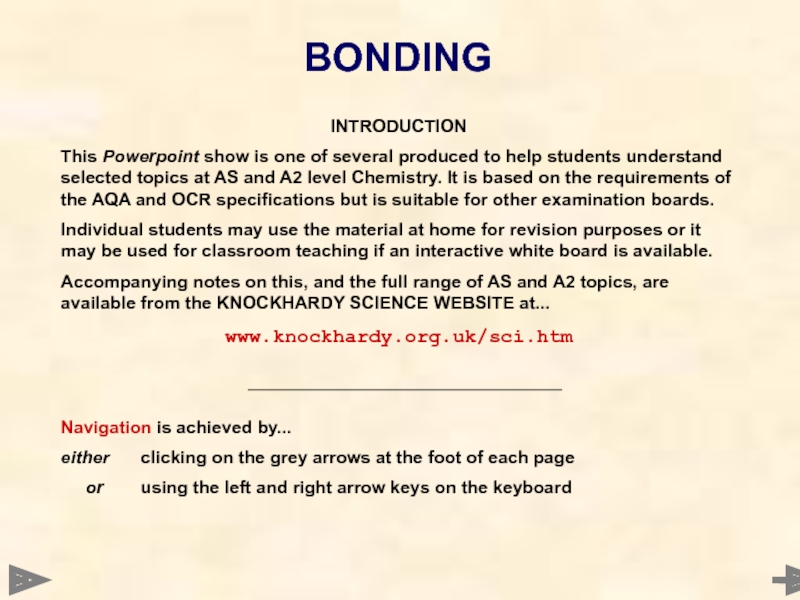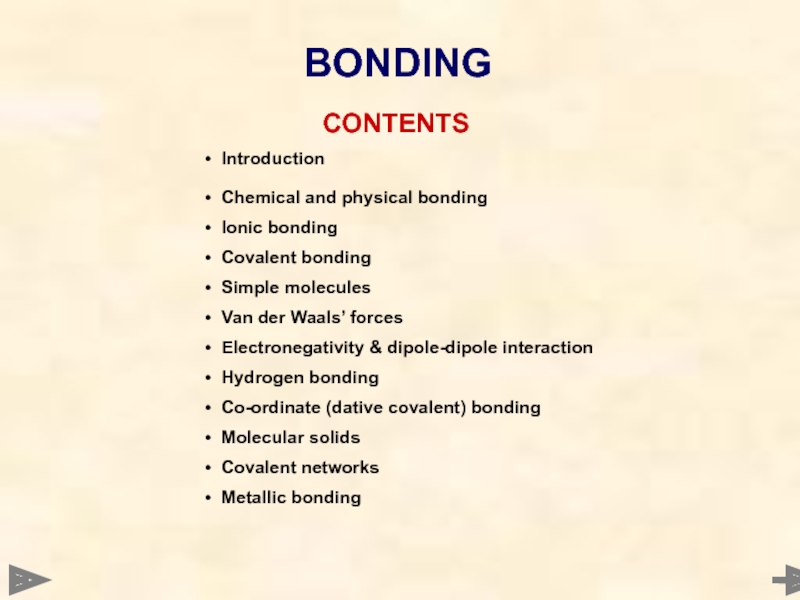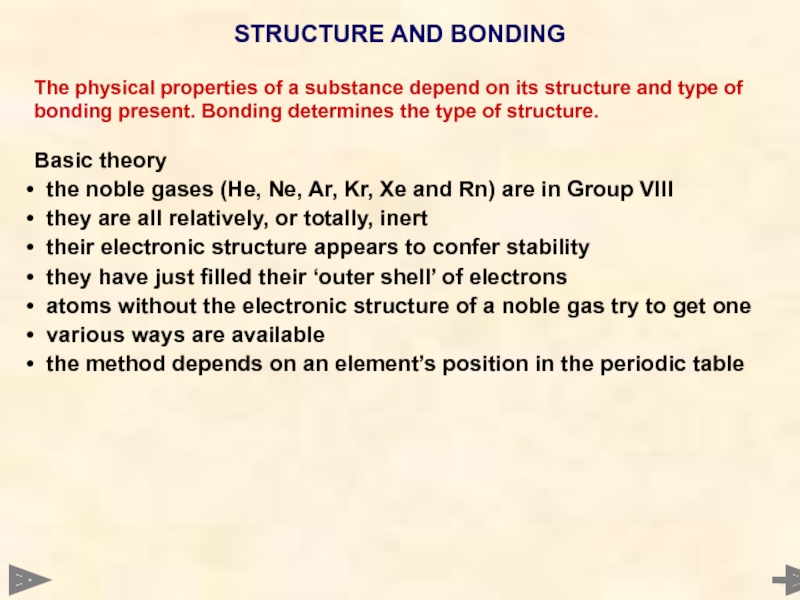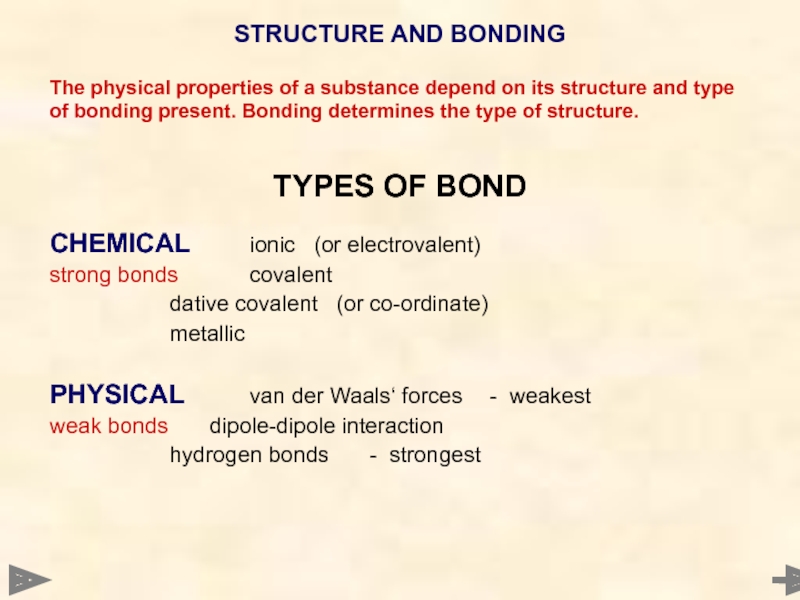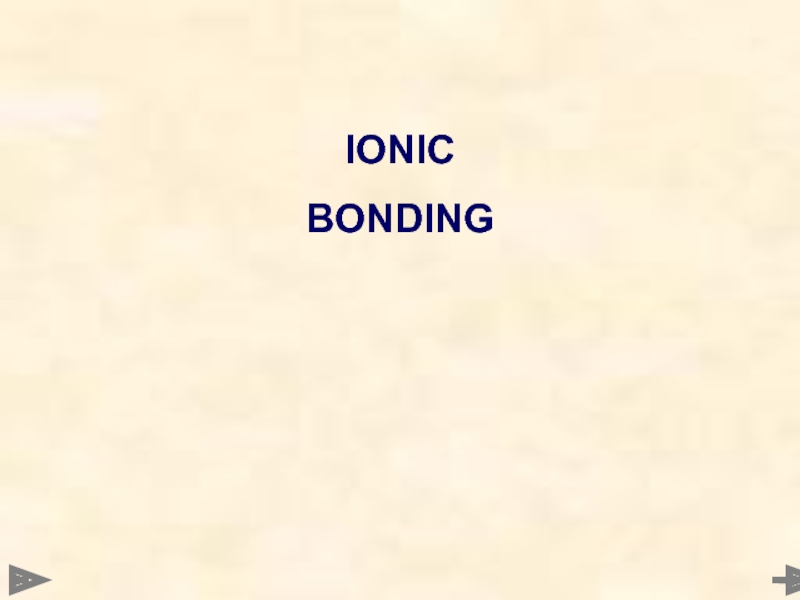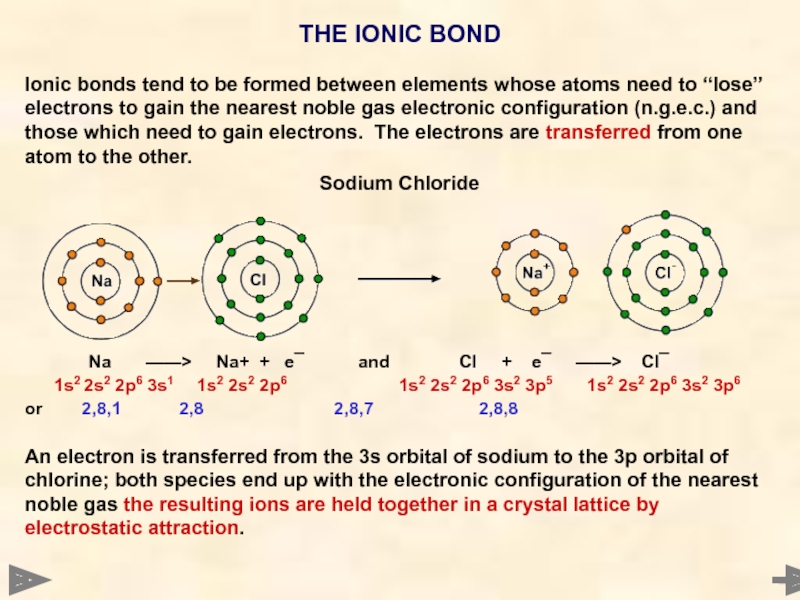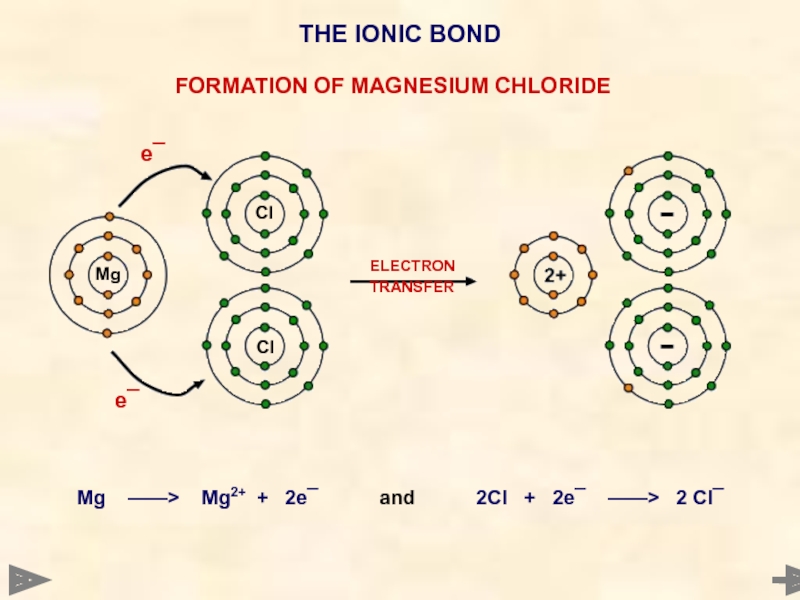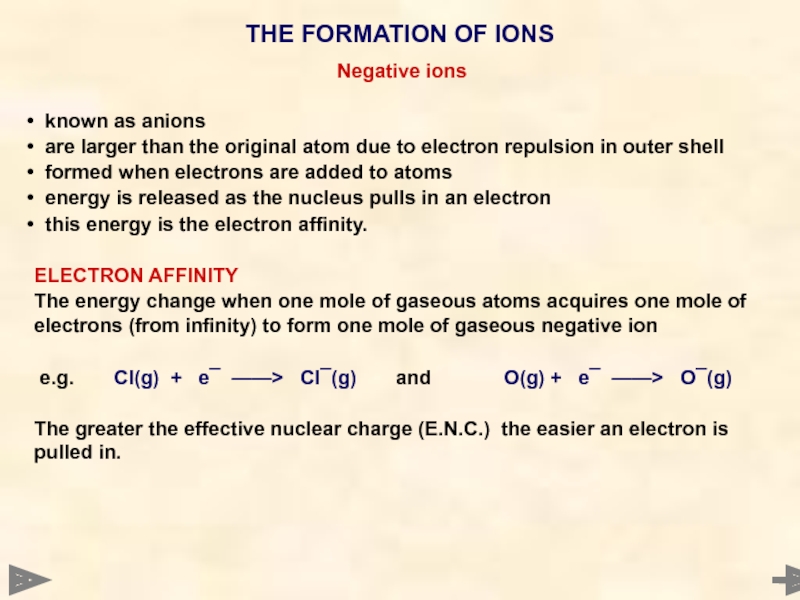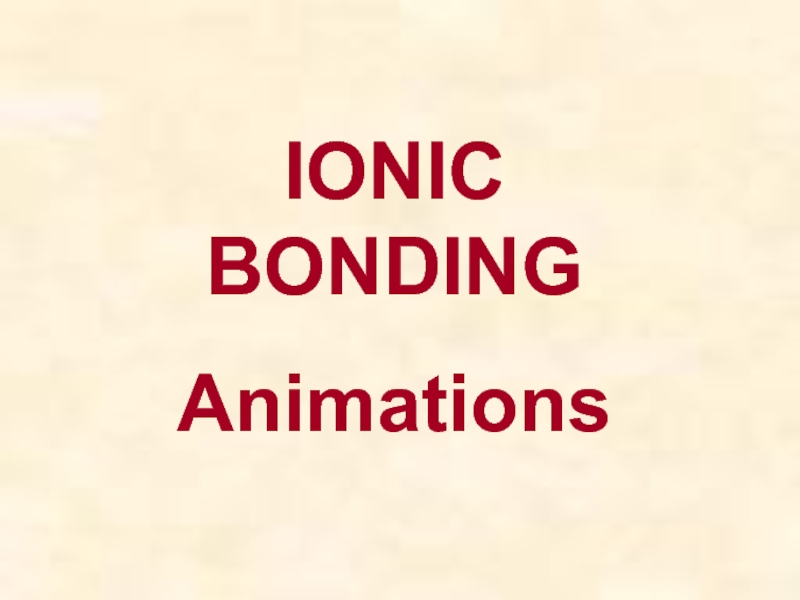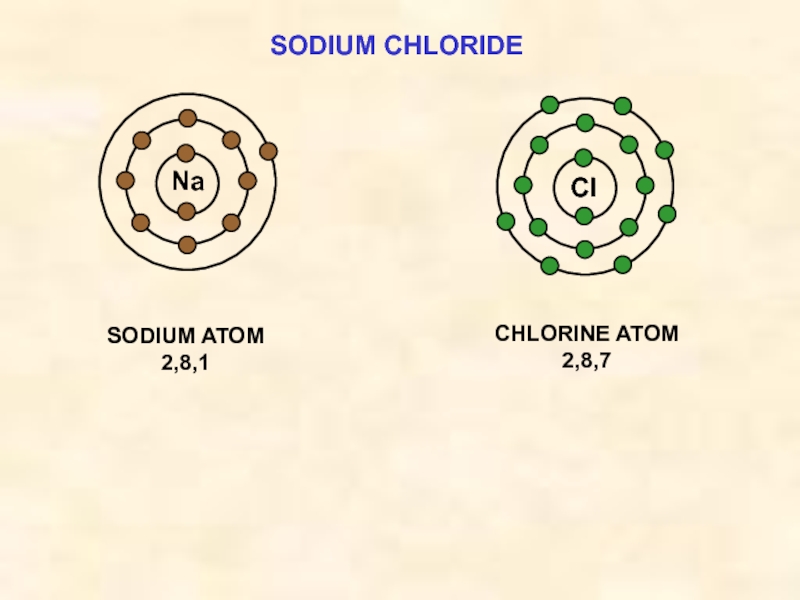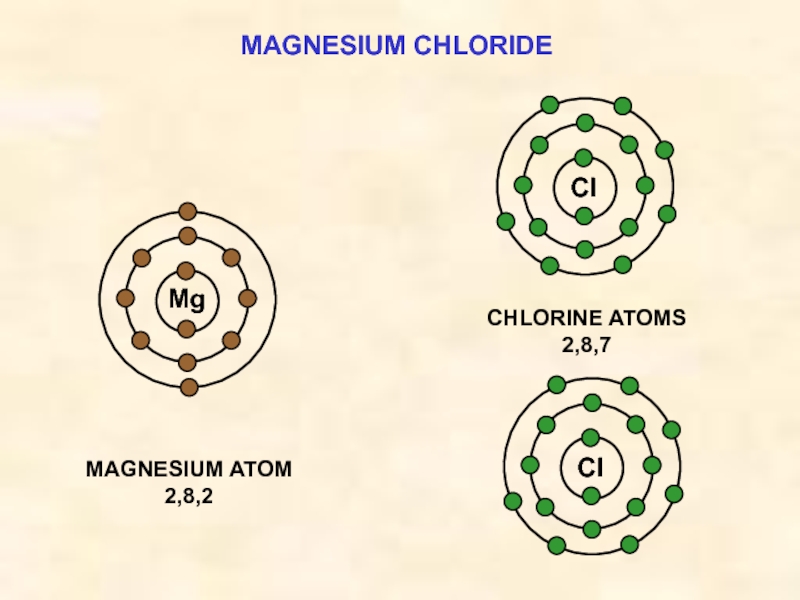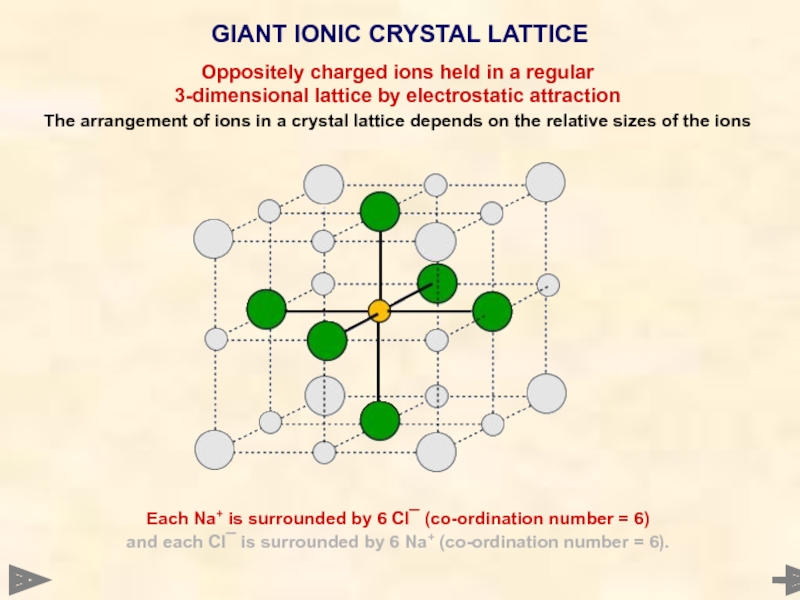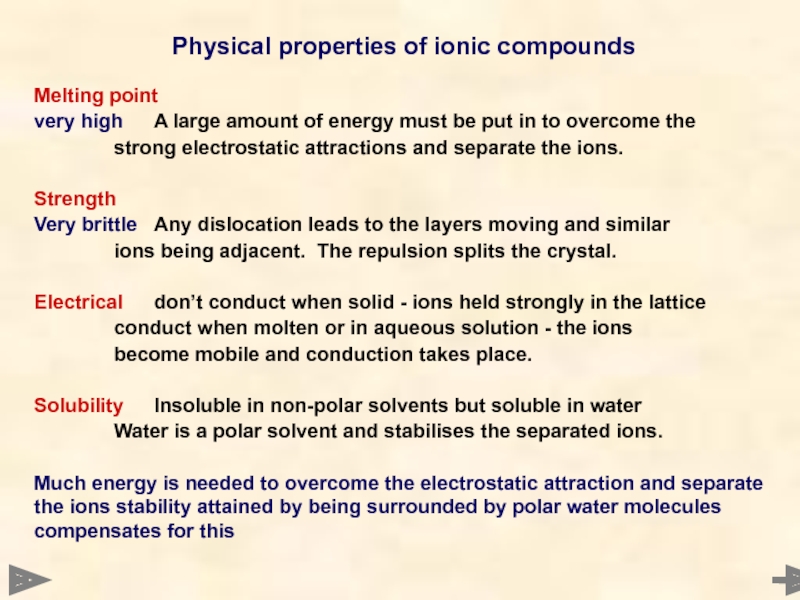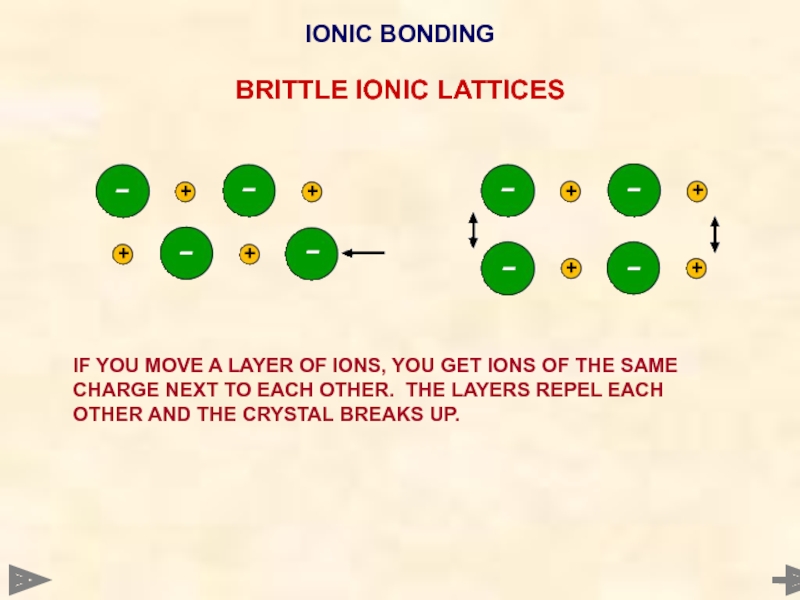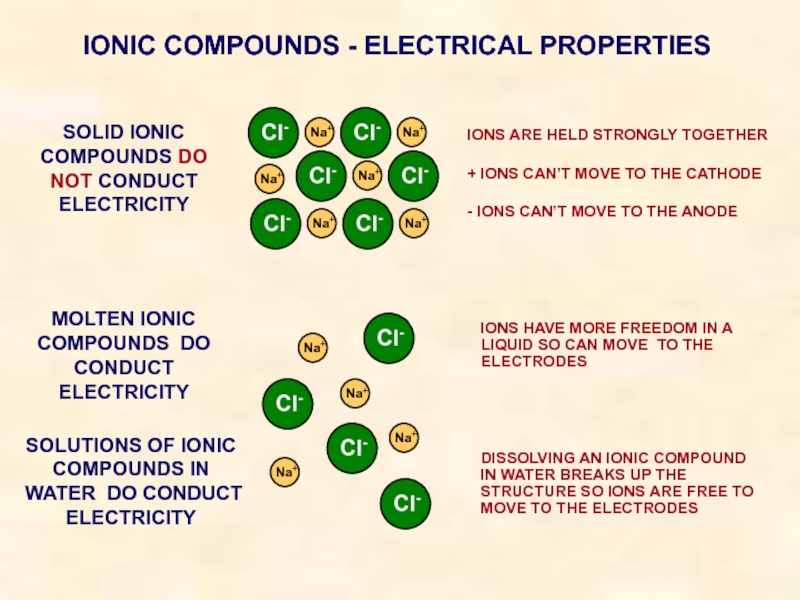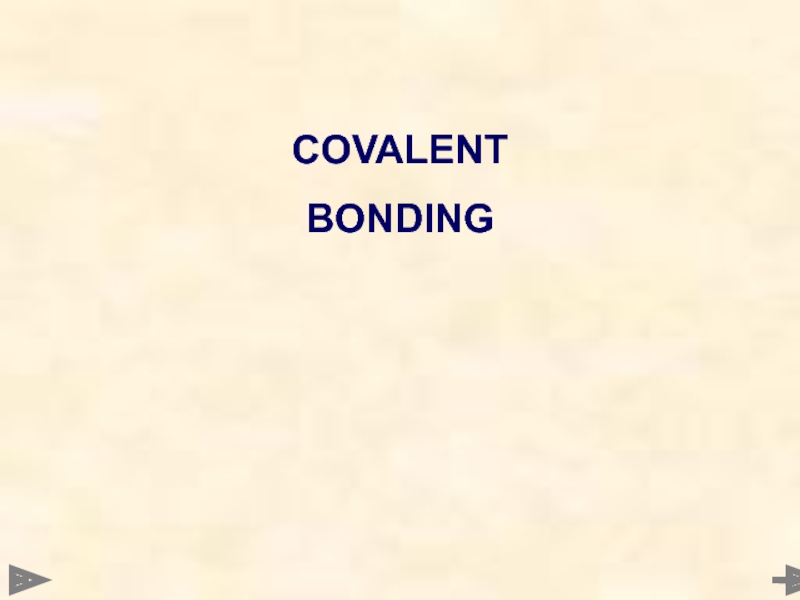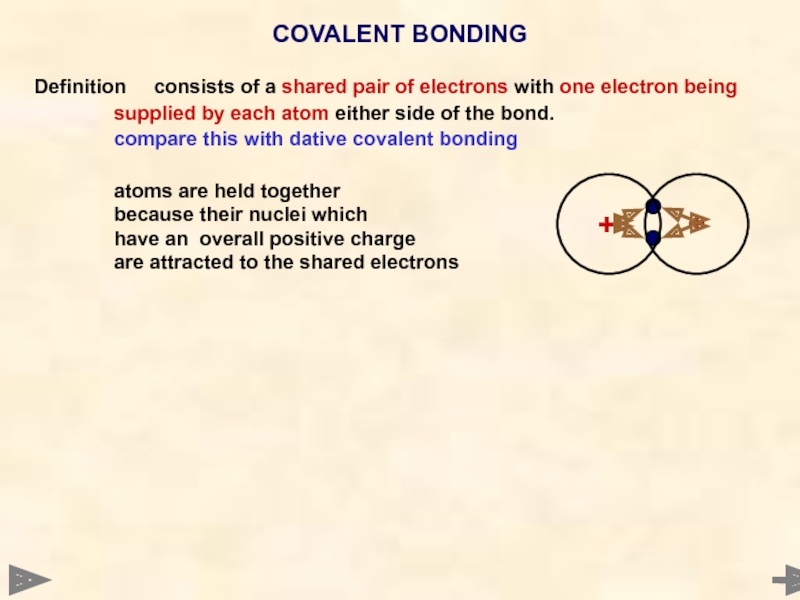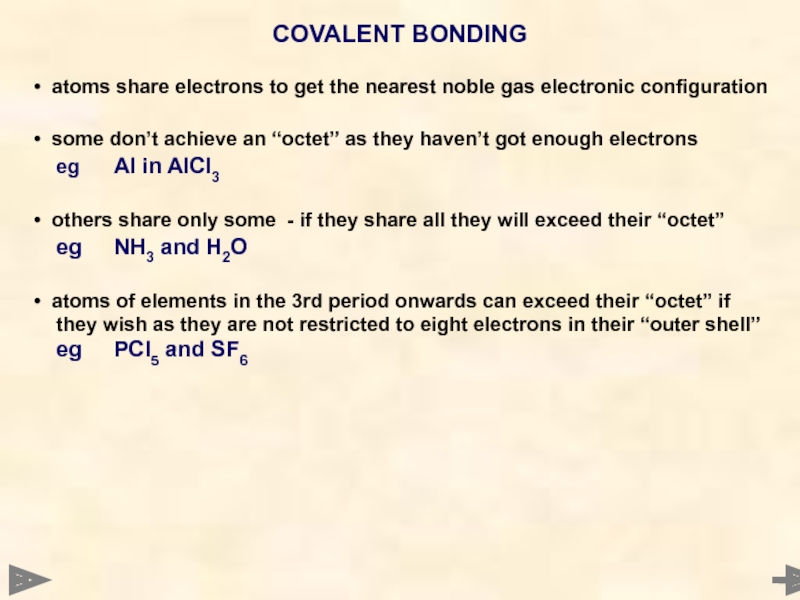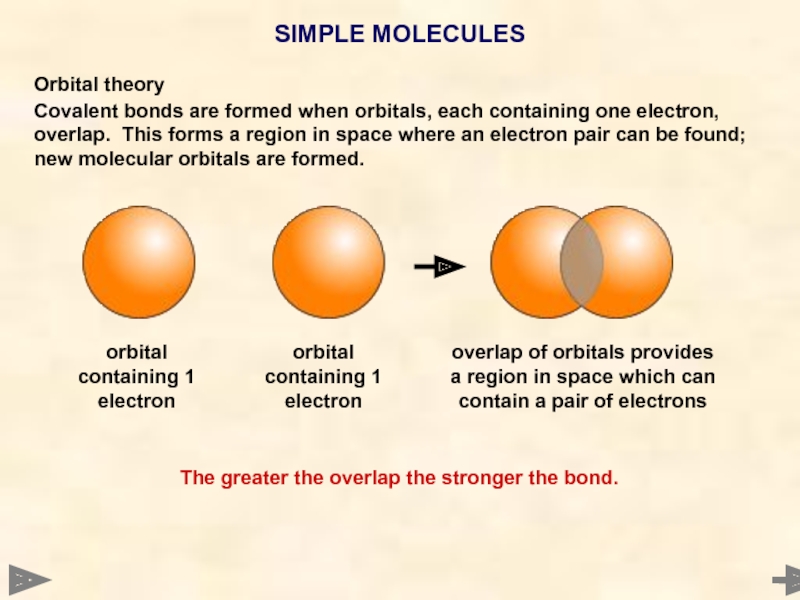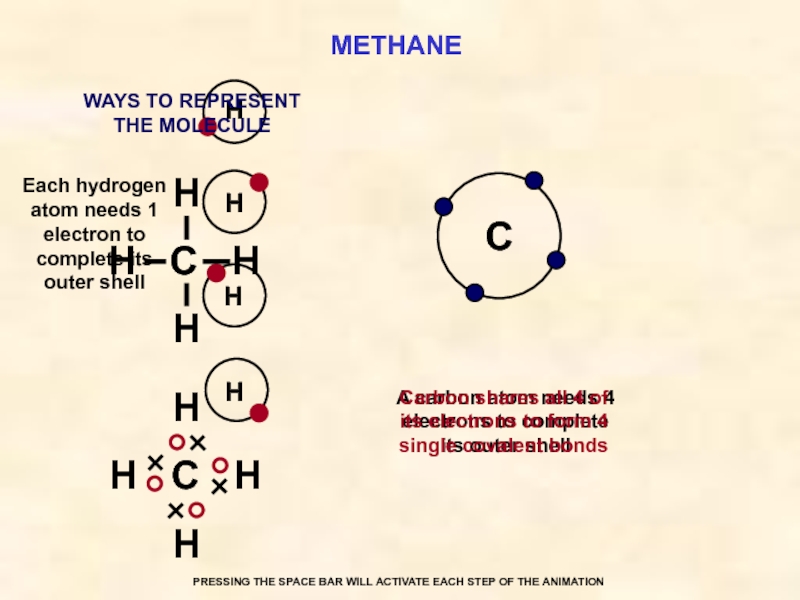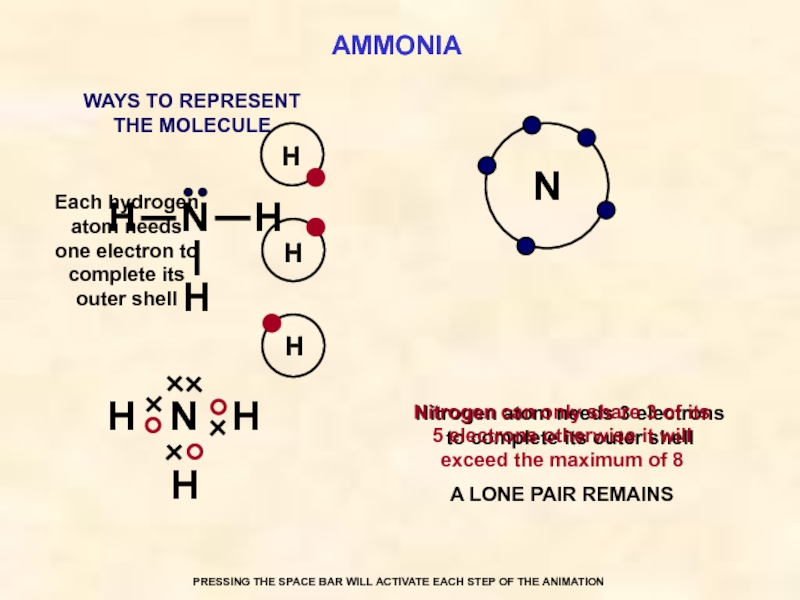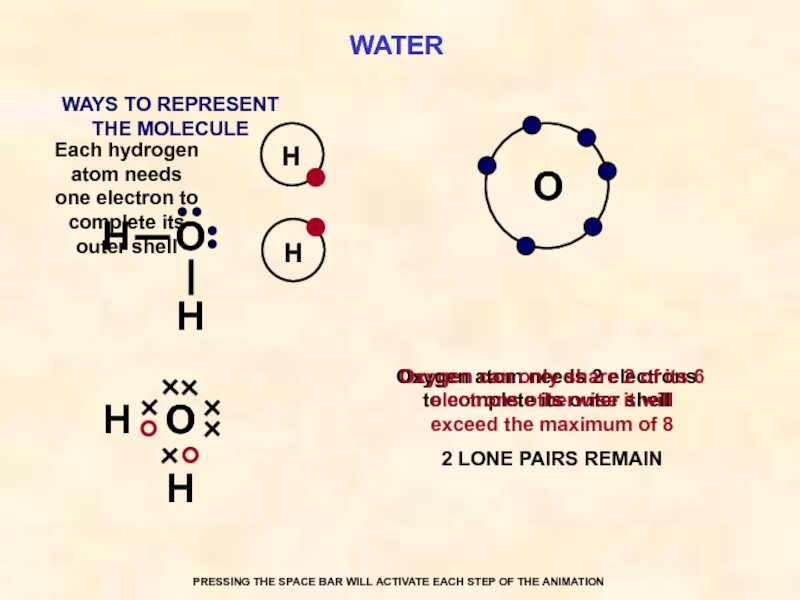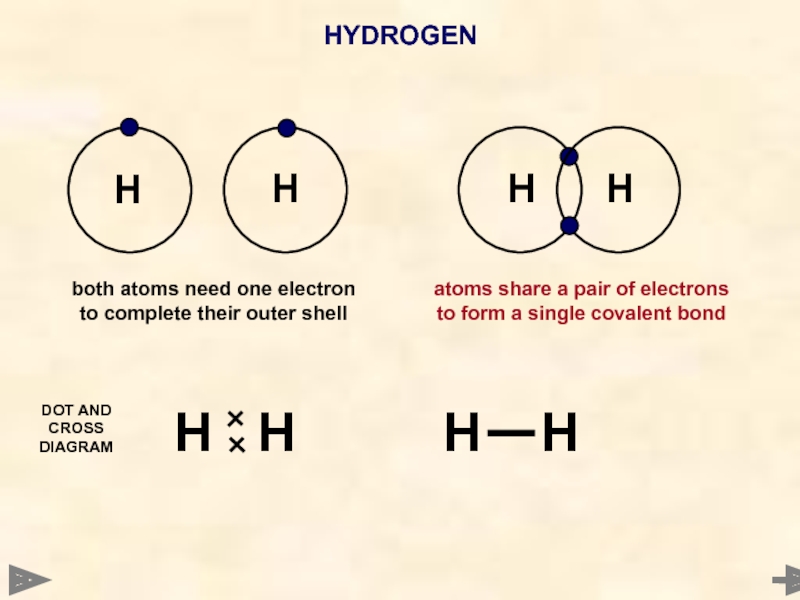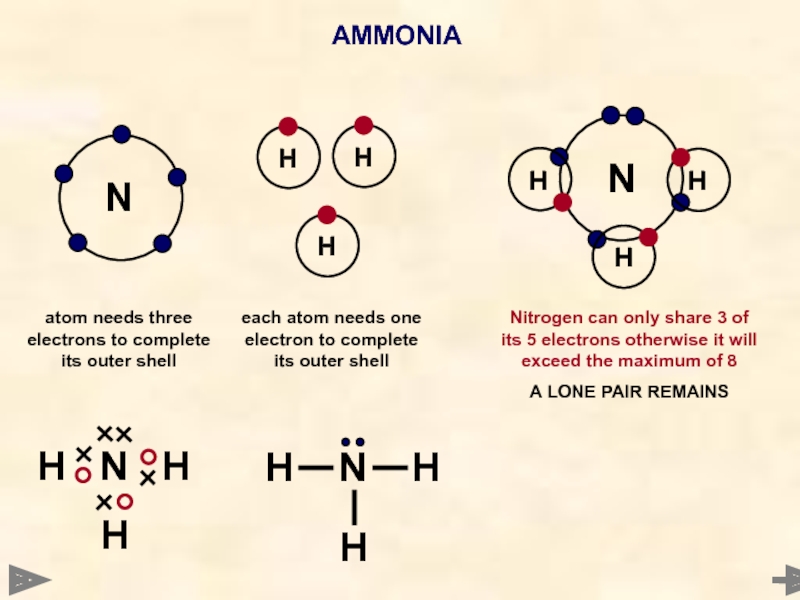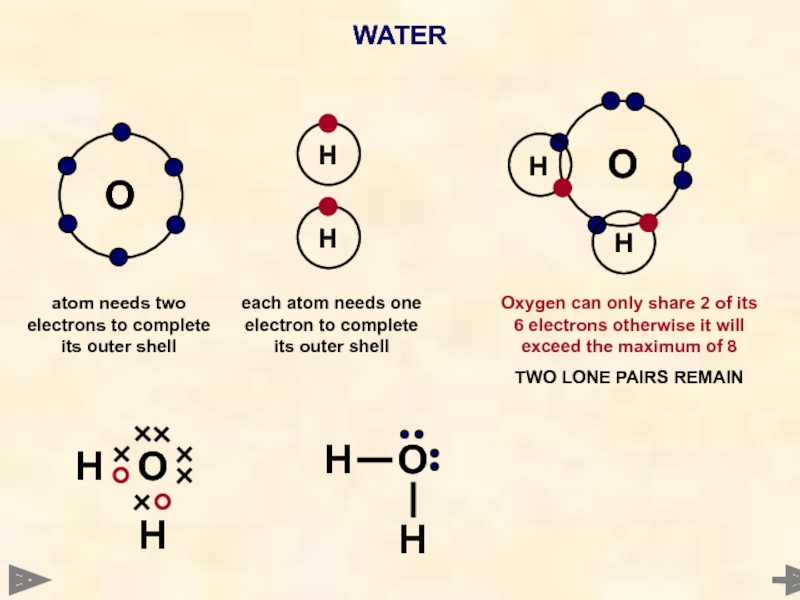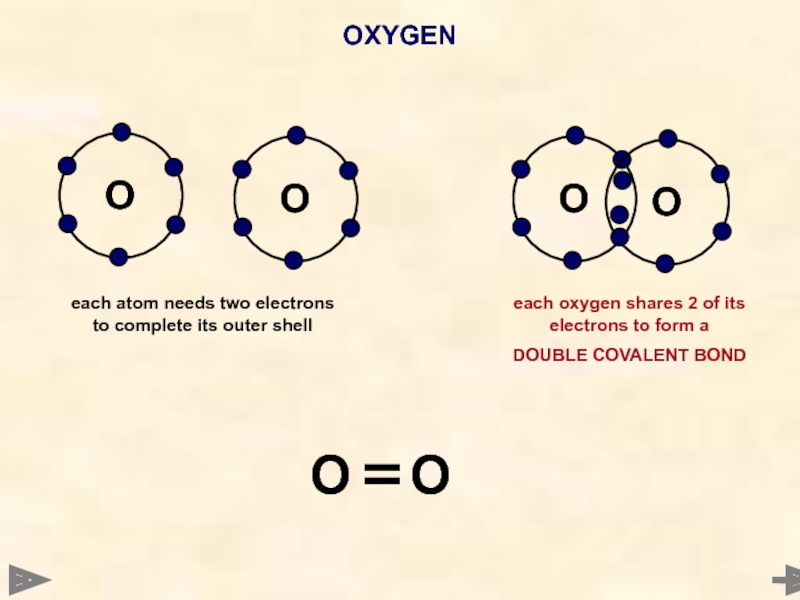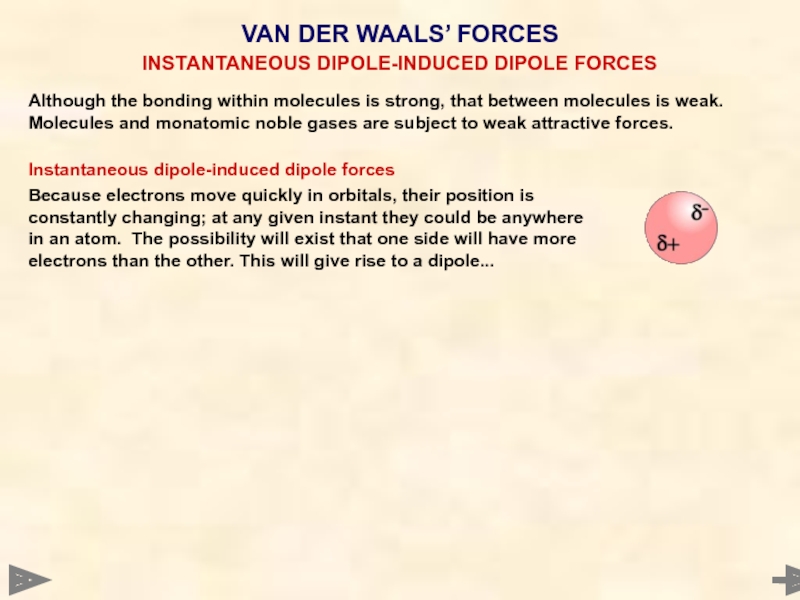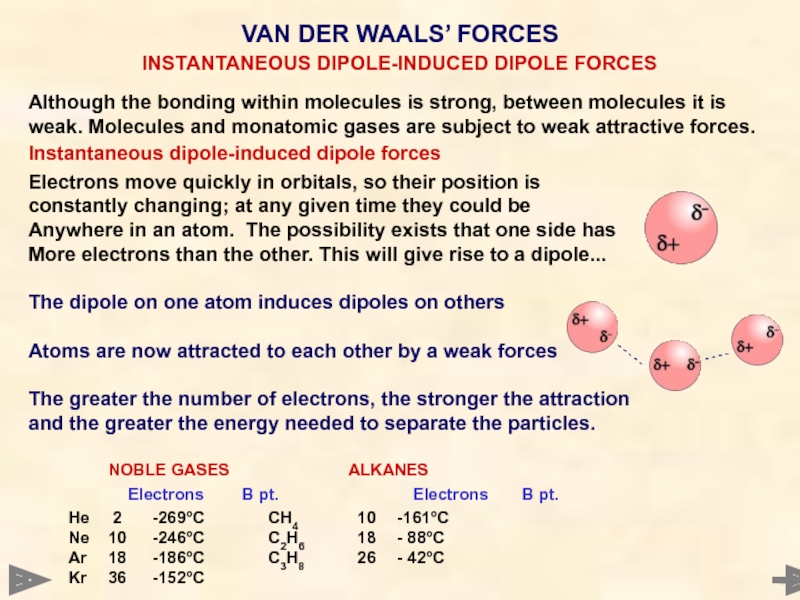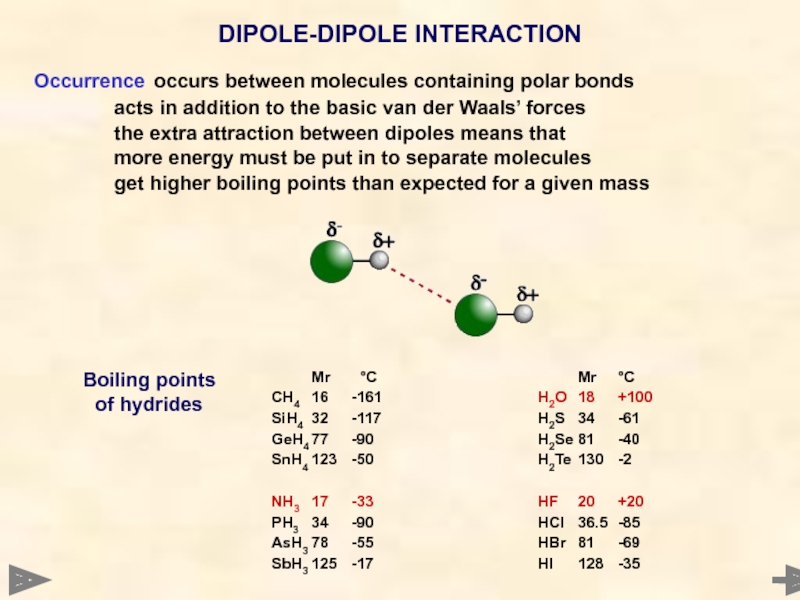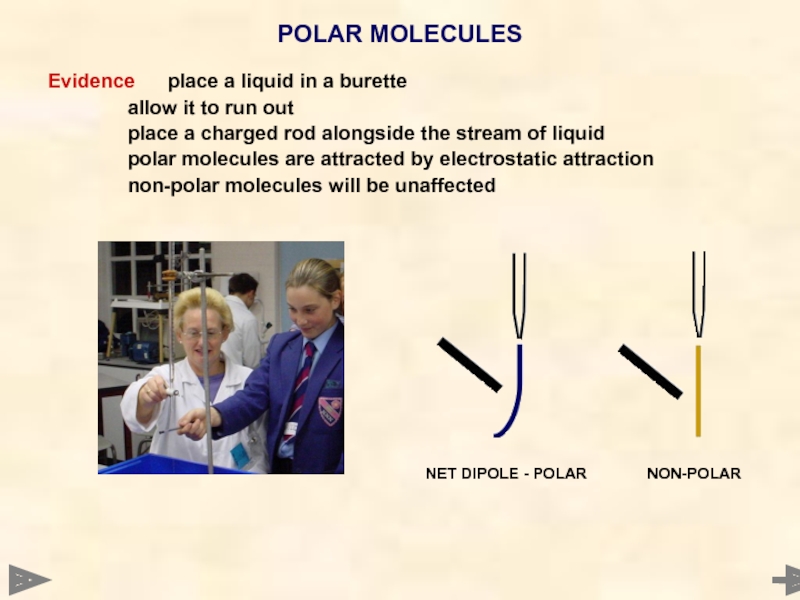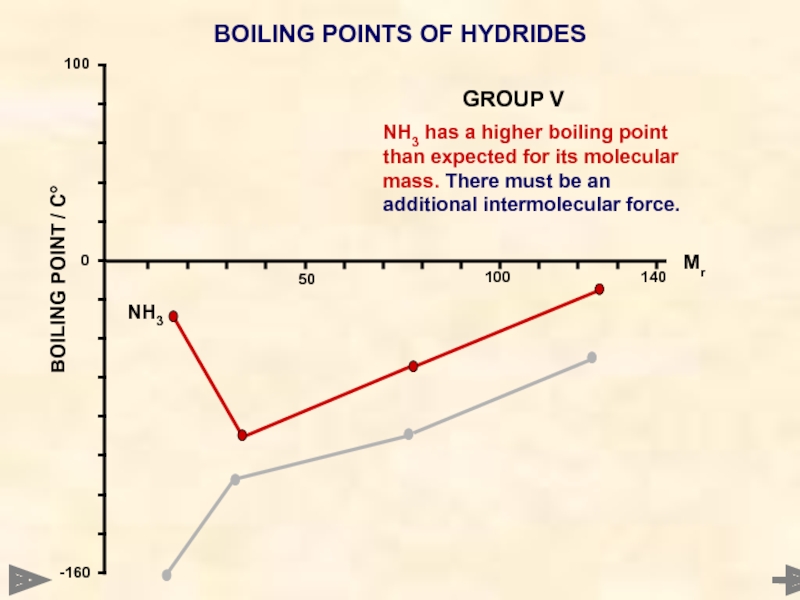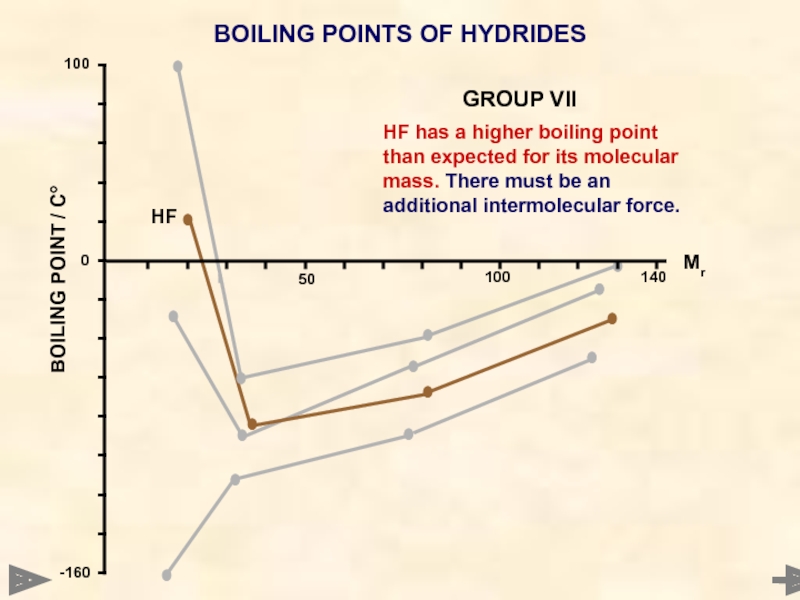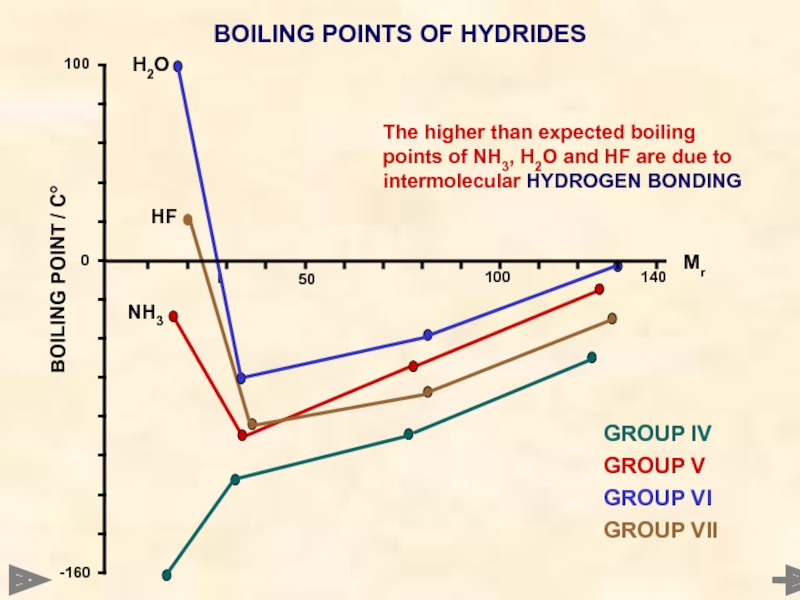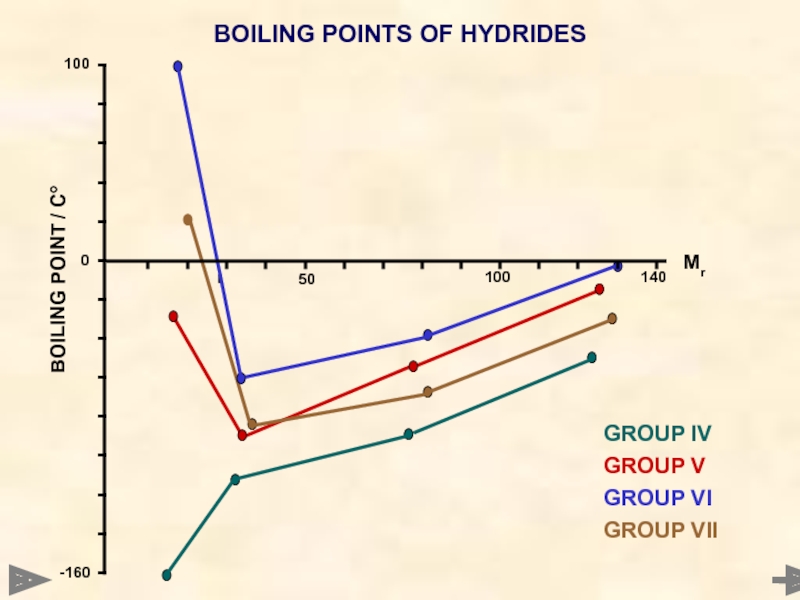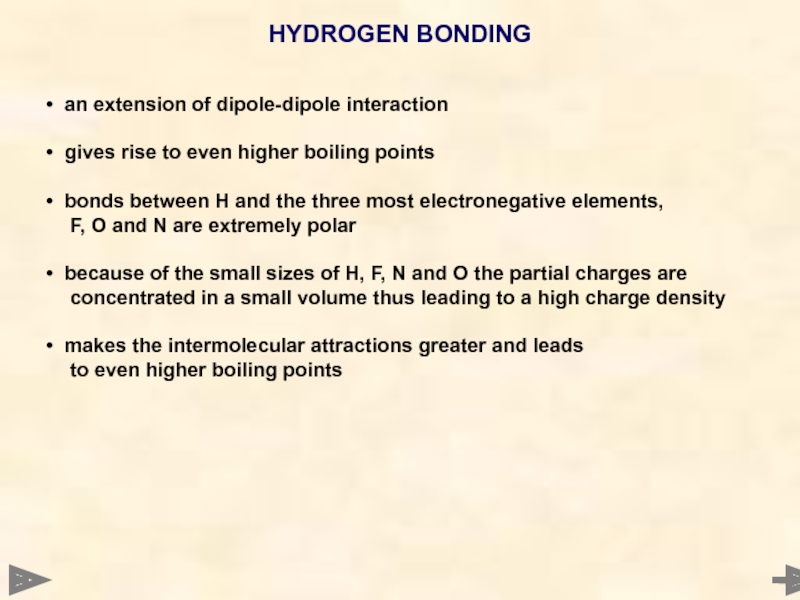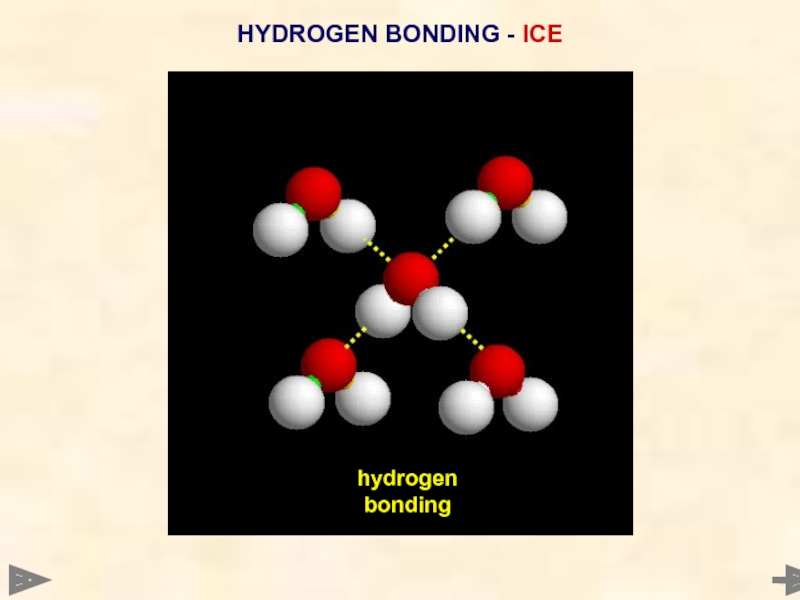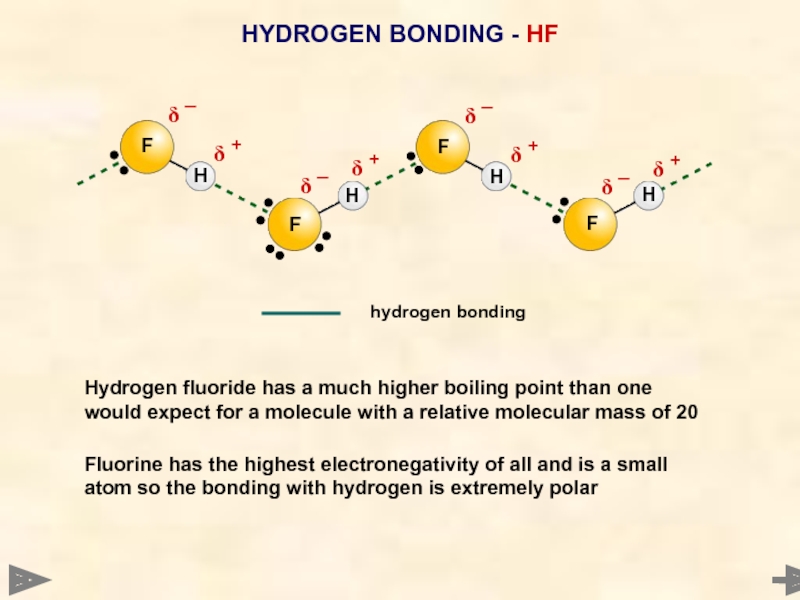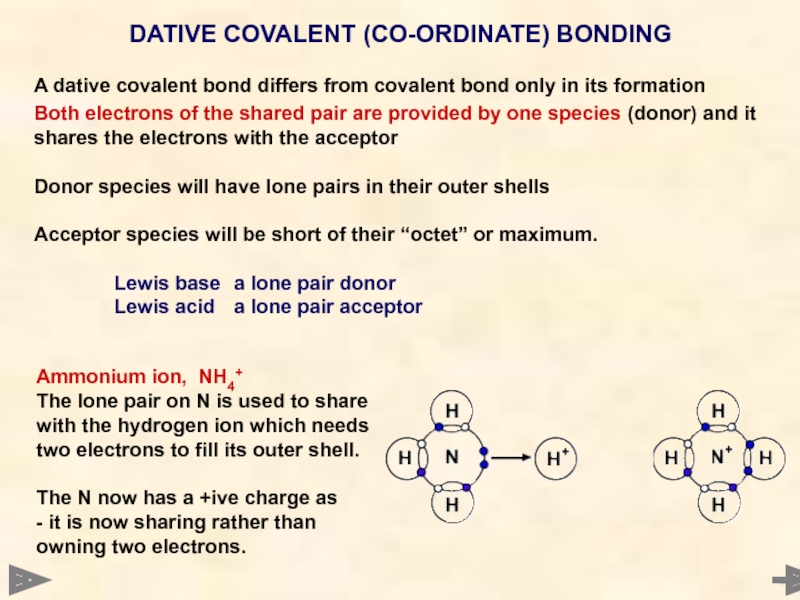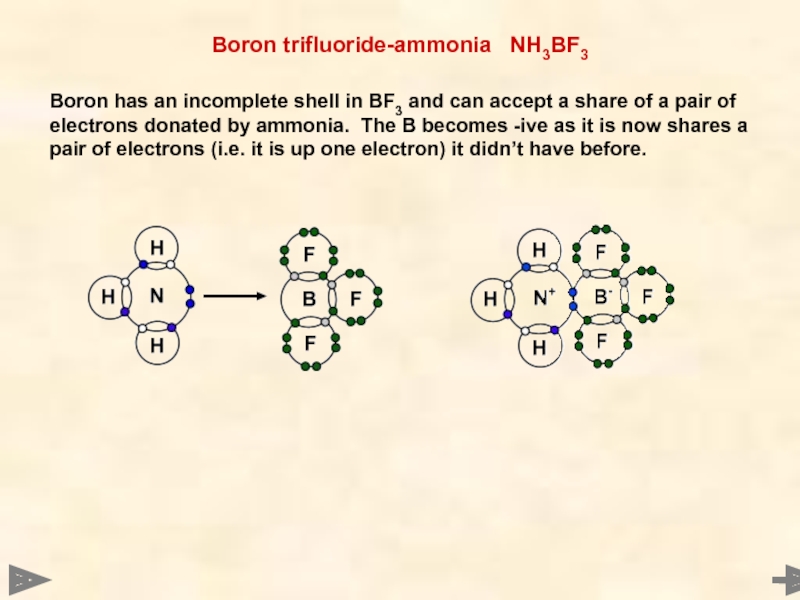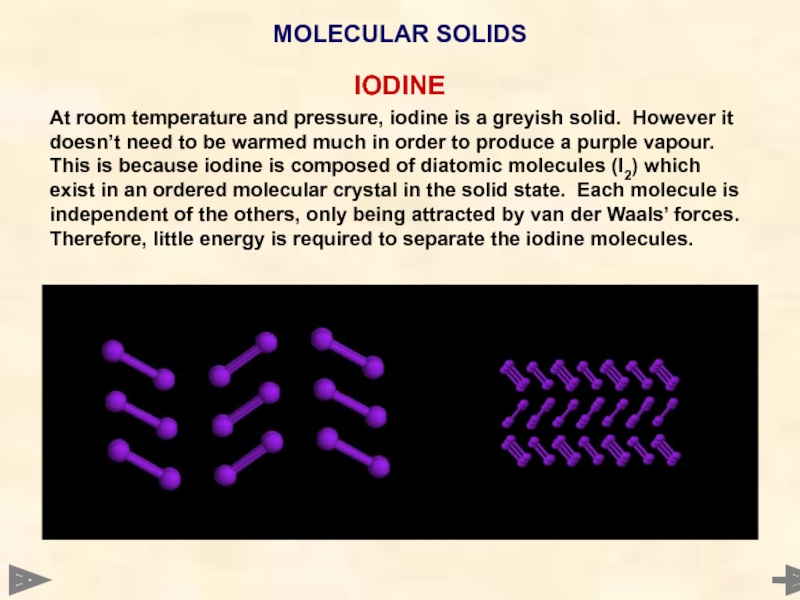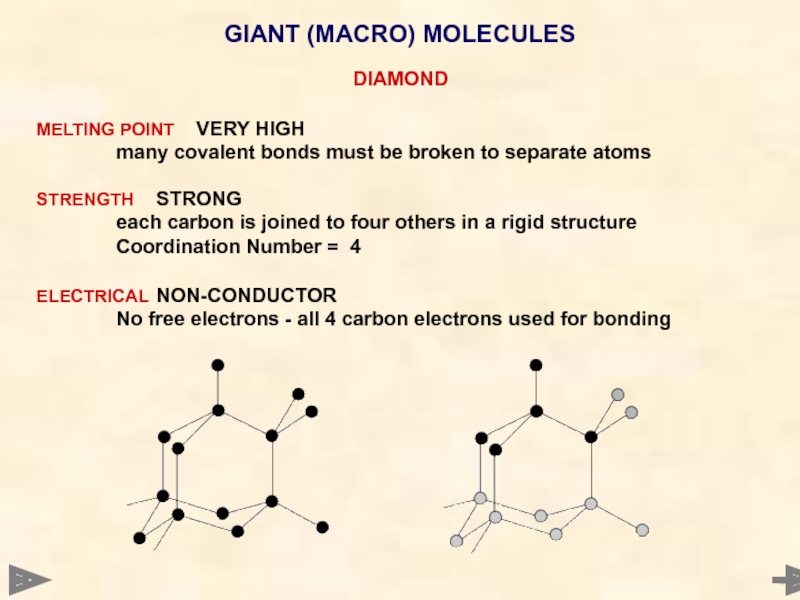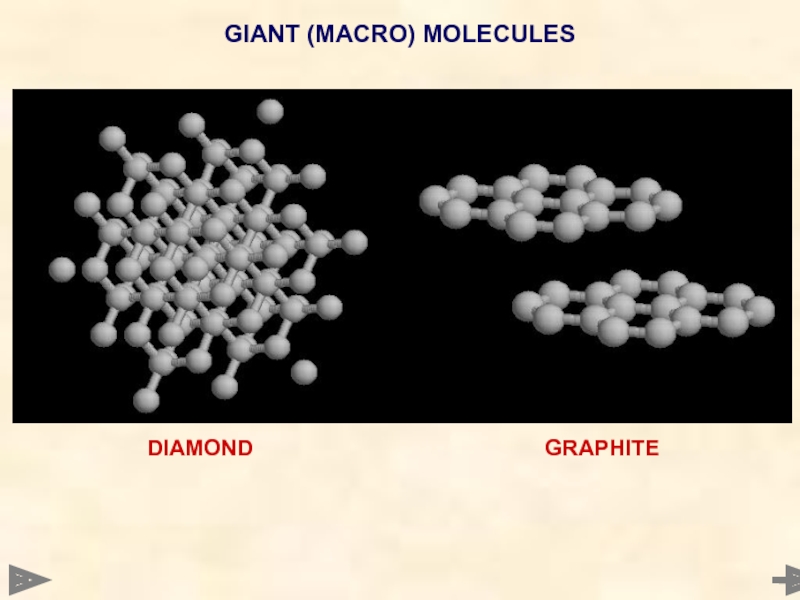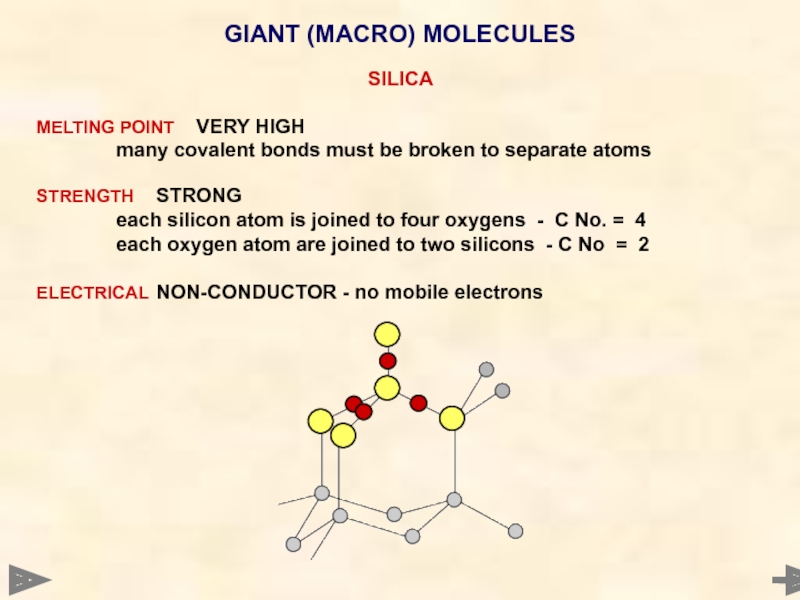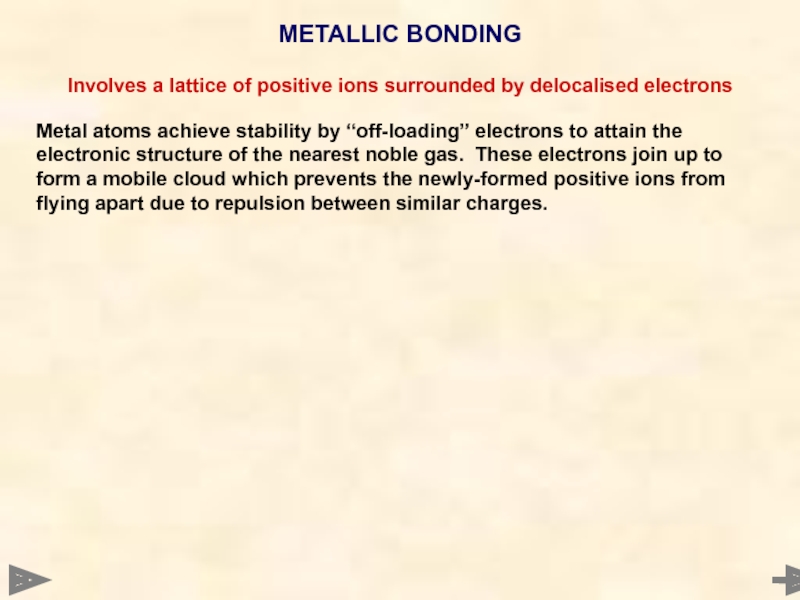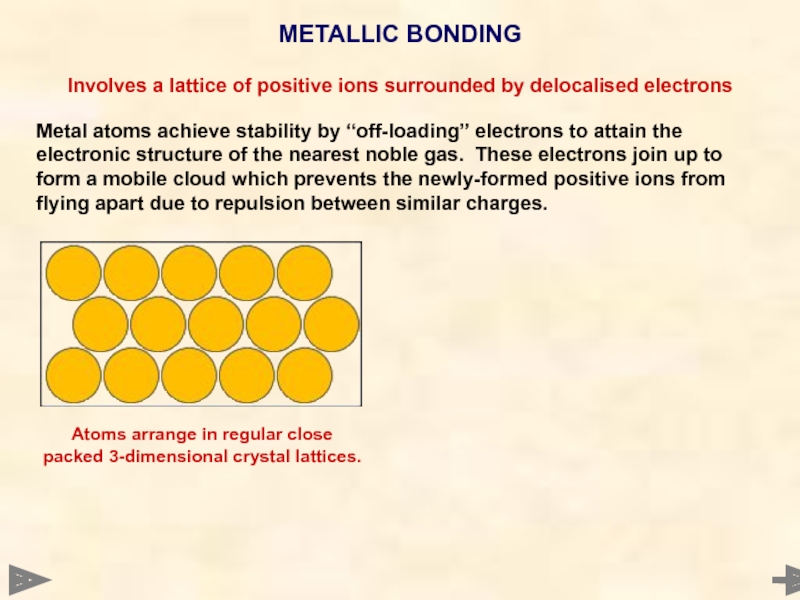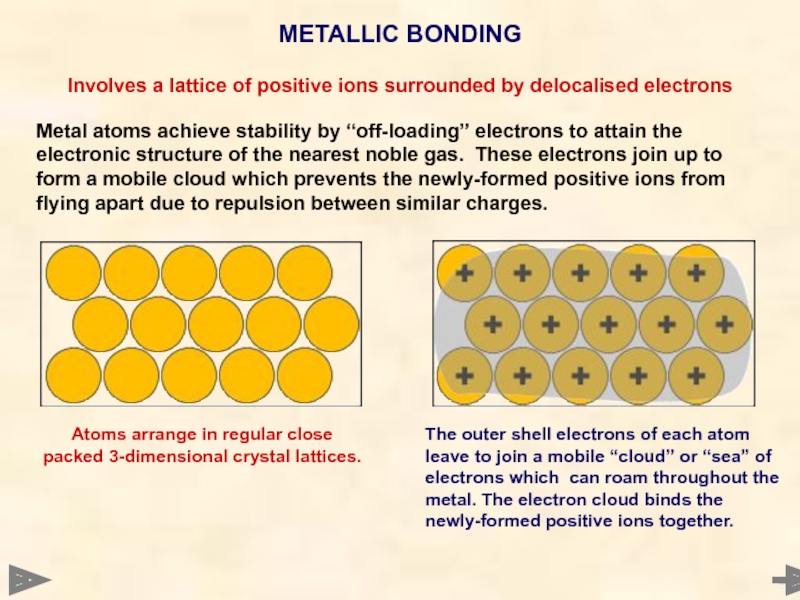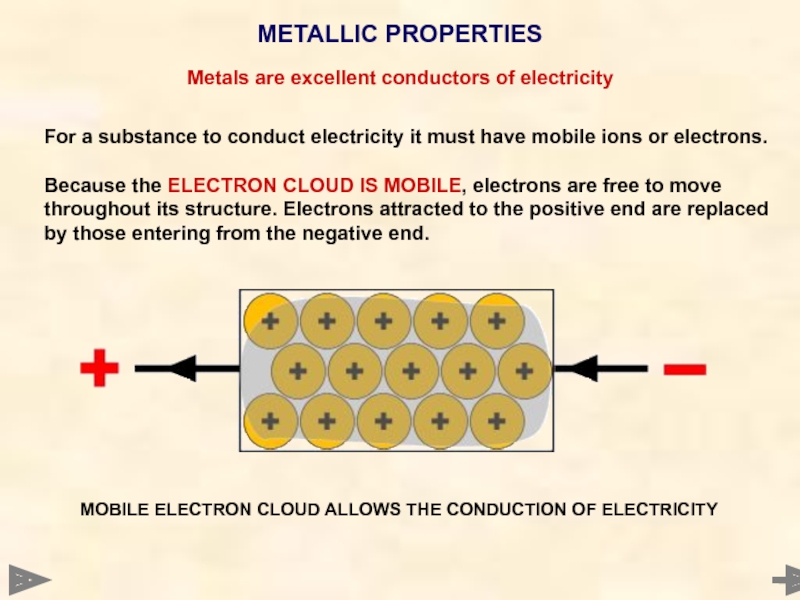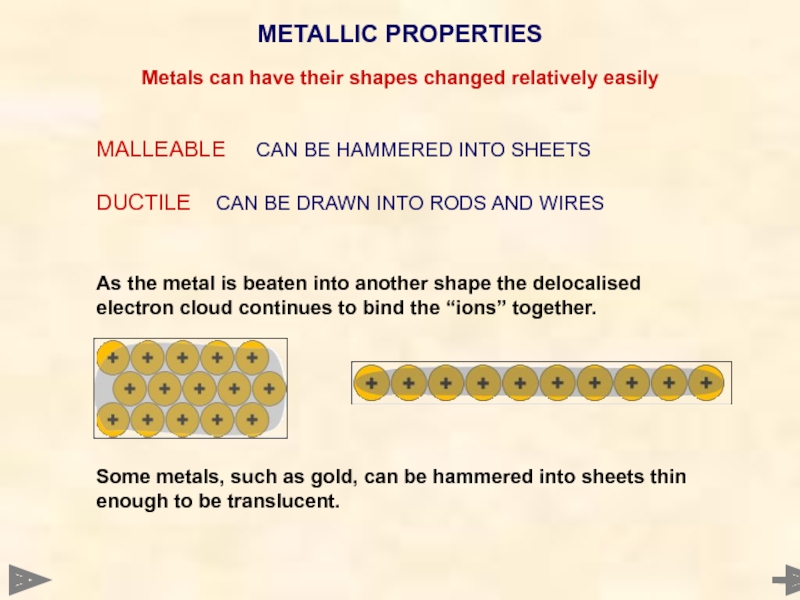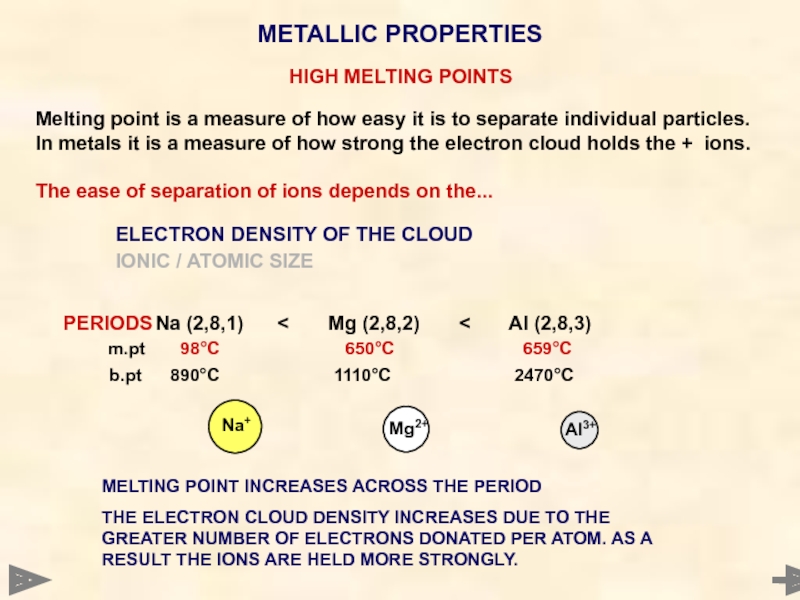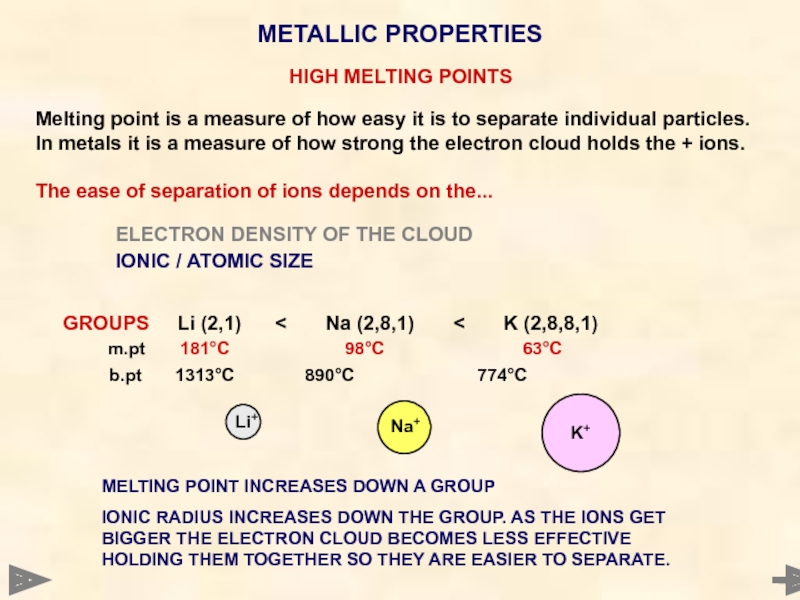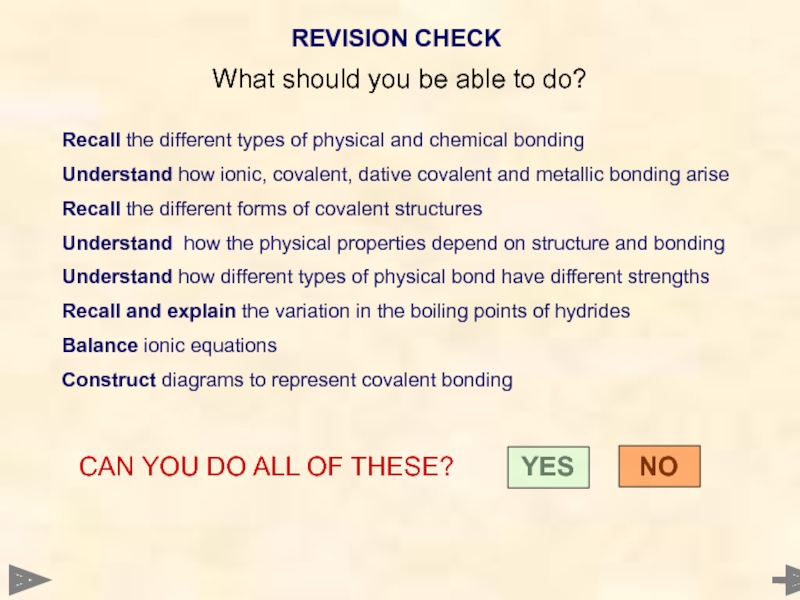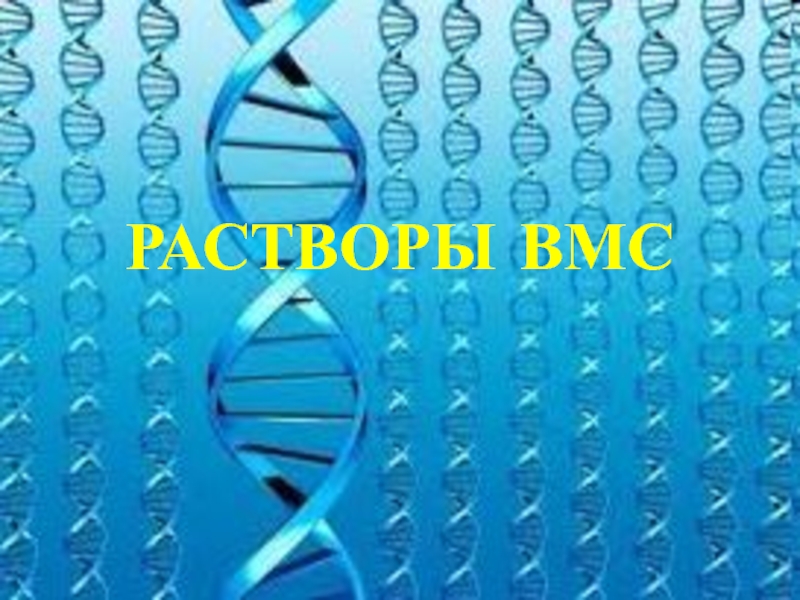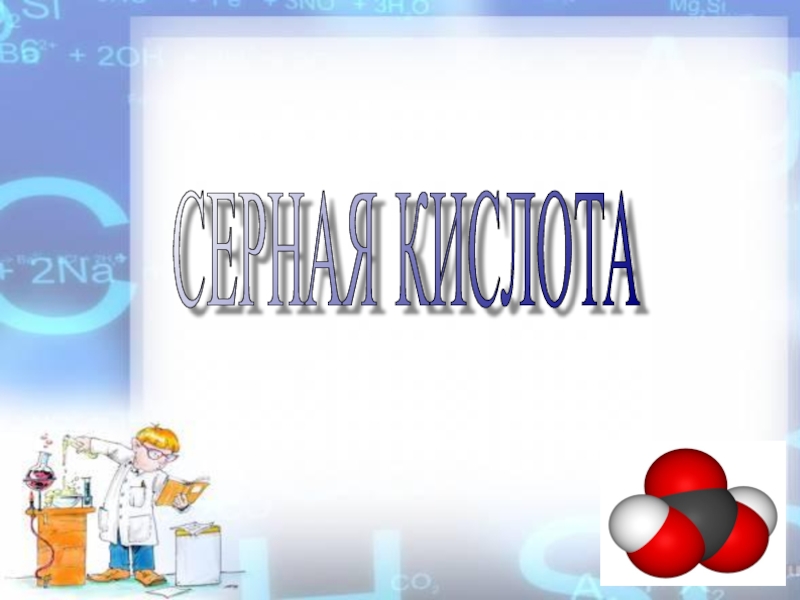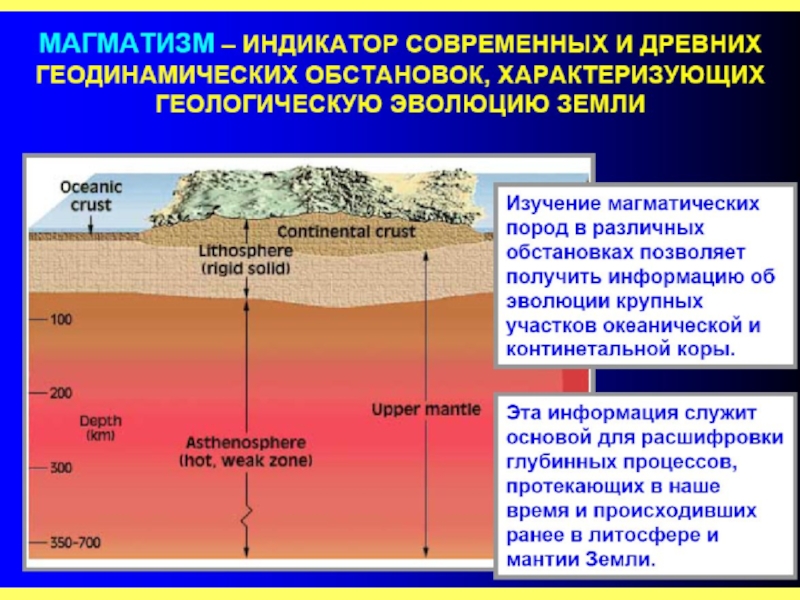- Главная
- Разное
- Дизайн
- Бизнес и предпринимательство
- Аналитика
- Образование
- Развлечения
- Красота и здоровье
- Финансы
- Государство
- Путешествия
- Спорт
- Недвижимость
- Армия
- Графика
- Культурология
- Еда и кулинария
- Лингвистика
- Английский язык
- Астрономия
- Алгебра
- Биология
- География
- Детские презентации
- Информатика
- История
- Литература
- Маркетинг
- Математика
- Медицина
- Менеджмент
- Музыка
- МХК
- Немецкий язык
- ОБЖ
- Обществознание
- Окружающий мир
- Педагогика
- Русский язык
- Технология
- Физика
- Философия
- Химия
- Шаблоны, картинки для презентаций
- Экология
- Экономика
- Юриспруденция
An introduction to bonding презентация
Содержание
- 1. An introduction to bonding
- 2. INTRODUCTION This Powerpoint show is
- 4. STRUCTURE AND BONDING The physical
- 5. STRUCTURE AND BONDING The physical
- 6. IONIC BONDING
- 7. THE IONIC BOND Ionic bonds
- 8. THE IONIC BOND Ionic bonds
- 9. THE IONIC BOND Ionic bonds
- 11. Positive ions also
- 12. Negative ions known
- 13. IONIC BONDING Animations
- 14. SODIUM CHLORIDE
- 15. SODIUM CHLORIDE
- 16. SODIUM CHLORIDE
- 17. MAGNESIUM CHLORIDE
- 18. MAGNESIUM CHLORIDE
- 19. GIANT IONIC CRYSTAL LATTICE
- 20. GIANT IONIC CRYSTAL LATTICE Each
- 21. GIANT IONIC CRYSTAL LATTICE Each
- 22. Physical properties of ionic compounds
- 23. IONIC BONDING BRITTLE IONIC LATTICES
- 24. IONIC COMPOUNDS - ELECTRICAL PROPERTIES SOLID IONIC
- 25. COVALENT BONDING
- 26. Definition consists of a shared pair
- 27. Definition consists of a shared pair
- 28. • atoms share electrons to
- 29. Orbital theory Covalent bonds are
- 30. HYDROGEN Another hydrogen atom also needs one
- 31. HYDROGEN CHLORIDE Cl
- 32. METHANE C Each hydrogen atom needs
- 33. AMMONIA N Each hydrogen
- 34. WATER O Each hydrogen
- 35. HYDROGEN H H H
- 36. METHANE
- 37. AMMONIA
- 38. WATER
- 39. OXYGEN O
- 40. Bonding Atoms are joined together within
- 41. Although the bonding within molecules
- 42. Although the bonding within molecules
- 43. Although the bonding within molecules
- 44. ‘The ability of an atom
- 45. ‘The ability of an atom
- 46. Occurrence occurs between molecules containing polar
- 47. Occurrence not all molecules containing polar
- 48. Evidence place a liquid in a
- 49. BOILING POINTS OF HYDRIDES Mr
- 50. BOILING POINTS OF HYDRIDES The
- 51. BOILING POINTS OF HYDRIDES NH3
- 52. BOILING POINTS OF HYDRIDES H2O
- 53. BOILING POINTS OF HYDRIDES HF
- 54. BOILING POINTS OF HYDRIDES GROUP
- 55. BOILING POINTS OF HYDRIDES GROUP IV GROUP V GROUP VI GROUP VII
- 56. an extension of dipole-dipole
- 57. HYDROGEN BONDING - ICE each
- 58. HYDROGEN BONDING - ICE hydrogen bonding
- 59. HYDROGEN BONDING - HF Hydrogen
- 60. A dative covalent bond differs
- 61. Boron trifluoride-ammonia NH3BF3
- 62. MOLECULAR SOLIDS
- 63. IODINE At room temperature
- 64. COVALENT NETWORKS GIANT MOLECULES MACROMOLECULES They all mean the same!
- 65. DIAMOND, GRAPHITE and SILICA
- 66. GIANT (MACRO) MOLECULES DIAMOND
- 67. GIANT (MACRO) MOLECULES GRAPHITE
- 68. GIANT (MACRO) MOLECULES DIAMOND GRAPHITE
- 69. GIANT (MACRO) MOLECULES SILICA
- 70. METALLIC BONDING
- 71. METALLIC BONDING Involves a lattice
- 72. METALLIC BONDING Involves a lattice
- 73. METALLIC BONDING Involves a lattice
- 74. METALLIC BOND STRENGTH Depends on
- 75. METALLIC BOND STRENGTH Depends on
- 76. METALLIC BOND STRENGTH Depends on
- 77. METALLIC PROPERTIES MOBILE ELECTRON CLOUD
- 78. MALLEABLE CAN BE HAMMERED INTO SHEETS
- 79. HIGH MELTING POINTS Melting
- 80. HIGH MELTING POINTS Melting
- 81. REVISION CHECK What should you be able
- 82. You need to go over the relevant
- 83. WELL DONE! Try some past paper questions
- 84. © 2008 JONATHAN HOPTON & KNOCKHARDY PUBLISHING AN INTRODUCTION TO BONDING THE END
Слайд 1AN INTRODUCTION TO BONDING
A guide for A level students
KNOCKHARDY PUBLISHING
2008 SPECIFICATIONS
Слайд 2
INTRODUCTION
This Powerpoint show is one of several produced to help students
Individual students may use the material at home for revision purposes or it may be used for classroom teaching if an interactive white board is available.
Accompanying notes on this, and the full range of AS and A2 topics, are available from the KNOCKHARDY SCIENCE WEBSITE at...
www.knockhardy.org.uk/sci.htm
Navigation is achieved by...
either clicking on the grey arrows at the foot of each page
or using the left and right arrow keys on the keyboard
BONDING
Слайд 3 CONTENTS
Introduction
Chemical
Ionic bonding
Covalent bonding
Simple molecules
Van der Waals’ forces
Electronegativity & dipole-dipole interaction
Hydrogen bonding
Co-ordinate (dative covalent) bonding
Molecular solids
Covalent networks
Metallic bonding
BONDING
Слайд 4
STRUCTURE AND BONDING
The physical properties of a substance depend on its
Basic theory
the noble gases (He, Ne, Ar, Kr, Xe and Rn) are in Group VIII
they are all relatively, or totally, inert
their electronic structure appears to confer stability
they have just filled their ‘outer shell’ of electrons
atoms without the electronic structure of a noble gas try to get one
various ways are available
the method depends on an element’s position in the periodic table
Слайд 5
STRUCTURE AND BONDING
The physical properties of a substance depend on its
TYPES OF BOND
CHEMICAL ionic (or electrovalent)
strong bonds covalent
dative covalent (or co-ordinate)
metallic
PHYSICAL van der Waals‘ forces - weakest
weak bonds dipole-dipole interaction
hydrogen bonds - strongest
Слайд 7
THE IONIC BOND
Ionic bonds tend to be formed between elements whose
Слайд 8
THE IONIC BOND
Ionic bonds tend to be formed between elements whose
Sodium Chloride
Na ——> Na+ + e¯ and Cl + e¯ ——> Cl¯
1s2 2s2 2p6 3s1 1s2 2s2 2p6 1s2 2s2 2p6 3s2 3p5 1s2 2s2 2p6 3s2 3p6
or 2,8,1 2,8 2,8,7 2,8,8
Слайд 9
THE IONIC BOND
Ionic bonds tend to be formed between elements whose
Sodium Chloride
Na ——> Na+ + e¯ and Cl + e¯ ——> Cl¯
1s2 2s2 2p6 3s1 1s2 2s2 2p6 1s2 2s2 2p6 3s2 3p5 1s2 2s2 2p6 3s2 3p6
or 2,8,1 2,8 2,8,7 2,8,8
An electron is transferred from the 3s orbital of sodium to the 3p orbital of chlorine; both species end up with the electronic configuration of the nearest noble gas the resulting ions are held together in a crystal lattice by electrostatic attraction.
Слайд 10
ELECTRON
TRANSFER
Mg ——> Mg2+ + 2e¯
Mg
Cl
Cl
e¯
e¯
THE IONIC BOND
FORMATION OF MAGNESIUM CHLORIDE
Слайд 11
Positive ions
also known as cations; they are smaller than the
formed when electrons are removed from atoms.
the energy associated with the process is known as the ionisation energy
1st IONISATION ENERGY (1st I.E.)
The energy required to remove one mole of electrons (to infinity) from the one mole of gaseous atoms to form one mole of gaseous positive ions.
e.g. Na(g) ——> Na+(g) + e¯ or Mg(g) ——> Mg+(g) + e¯
Other points
Successive IE’s get larger as the proton:electron ratio increases.
Large jumps in value occur when electrons are removed from shells nearer the nucleus because there is less shielding and more energy is required to overcome the attraction. If the I.E. values are very high, covalent bonding will be favoured (e.g. beryllium).
THE FORMATION OF IONS
Слайд 12
Negative ions
known as anions
are larger than the original atom
formed when electrons are added to atoms
energy is released as the nucleus pulls in an electron
this energy is the electron affinity.
ELECTRON AFFINITY
The energy change when one mole of gaseous atoms acquires one mole of electrons (from infinity) to form one mole of gaseous negative ion
e.g. Cl(g) + e¯ ——> Cl¯(g) and O(g) + e¯ ——> O¯(g)
The greater the effective nuclear charge (E.N.C.) the easier an electron is pulled in.
THE FORMATION OF IONS
Слайд 15SODIUM CHLORIDE
Cl
SODIUM ION
2,8
Na
CHLORIDE ION
2,8,8
both species now have ‘full’ outer shells; ie
+
Слайд 16SODIUM CHLORIDE
Cl
SODIUM ION
2,8
Na
CHLORIDE ION
2,8,8
Na Na+ + e¯
2,8,1
ELECTRON TRANSFERRED
Cl + e¯ Cl¯
2,8,7 2,8,8
+
Слайд 19
GIANT IONIC CRYSTAL LATTICE
Cl-
Chloride ion
Na+
Sodium ion
Oppositely charged ions held in a
3-dimensional lattice by electrostatic attraction
The arrangement of ions in a crystal lattice depends on the relative sizes of the ions
The Na+ ion is small enough relative to a Cl¯ ion to fit in the spaces so that both ions occur in every plane.
Слайд 20
GIANT IONIC CRYSTAL LATTICE
Each Na+ is surrounded by 6 Cl¯ (co-ordination
and each Cl¯ is surrounded by 6 Na+ (co-ordination number = 6).
Oppositely charged ions held in a regular
3-dimensional lattice by electrostatic attraction
The arrangement of ions in a crystal lattice depends on the relative sizes of the ions
Слайд 21
GIANT IONIC CRYSTAL LATTICE
Each Na+ is surrounded by 6 Cl¯ (co-ordination
and each Cl¯ is surrounded by 6 Na+ (co-ordination number = 6).
Oppositely charged ions held in a regular
3-dimensional lattice by electrostatic attraction
The arrangement of ions in a crystal lattice depends on the relative sizes of the ions
Слайд 22
Physical properties of ionic compounds
Melting point
very high A large amount of energy
strong electrostatic attractions and separate the ions.
Strength
Very brittle Any dislocation leads to the layers moving and similar
ions being adjacent. The repulsion splits the crystal.
Electrical don’t conduct when solid - ions held strongly in the lattice
conduct when molten or in aqueous solution - the ions
become mobile and conduction takes place.
Solubility Insoluble in non-polar solvents but soluble in water
Water is a polar solvent and stabilises the separated ions.
Much energy is needed to overcome the electrostatic attraction and separate the ions stability attained by being surrounded by polar water molecules compensates for this
Слайд 23
IONIC BONDING
BRITTLE IONIC LATTICES
IF YOU MOVE A LAYER OF IONS, YOU
Слайд 24IONIC COMPOUNDS - ELECTRICAL PROPERTIES
SOLID IONIC COMPOUNDS DO NOT CONDUCT ELECTRICITY
IONS
+ IONS CAN’T MOVE TO THE CATHODE
- IONS CAN’T MOVE TO THE ANODE
MOLTEN IONIC COMPOUNDS DO CONDUCT ELECTRICITY
IONS HAVE MORE FREEDOM IN A LIQUID SO CAN MOVE TO THE ELECTRODES
SOLUTIONS OF IONIC COMPOUNDS IN WATER DO CONDUCT ELECTRICITY
DISSOLVING AN IONIC COMPOUND IN WATER BREAKS UP THE STRUCTURE SO IONS ARE FREE TO MOVE TO THE ELECTRODES
Слайд 26
Definition consists of a shared pair of electrons with one electron being
supplied
compare this with dative covalent bonding
atoms are held together
because their nuclei which
have an overall positive charge
are attracted to the shared electrons
COVALENT BONDING
+
+
Слайд 27
Definition consists of a shared pair of electrons with one electron being
supplied
compare this with dative covalent bonding
atoms are held together
because their nuclei which
have an overall positive charge
are attracted to the shared electrons
Formation between atoms of the same element N2, O2, diamond,
graphite
between atoms of different elements CO2, SO2
on the RHS of the table;
when one of the elements is in the CCl4, SiCl4
middle of the table;
with head-of-the-group elements BeCl2
with high ionisation energies;
COVALENT BONDING
+
+
Слайд 28
• atoms share electrons to get the nearest noble gas electronic
• some don’t achieve an “octet” as they haven’t got enough electrons
eg Al in AlCl3
• others share only some - if they share all they will exceed their “octet”
eg NH3 and H2O
• atoms of elements in the 3rd period onwards can exceed their “octet” if
they wish as they are not restricted to eight electrons in their “outer shell”
eg PCl5 and SF6
COVALENT BONDING
Слайд 29
Orbital theory
Covalent bonds are formed when orbitals, each containing one electron,
SIMPLE MOLECULES
The greater the overlap the stronger the bond.
orbital containing 1 electron
orbital containing 1 electron
overlap of orbitals provides a region in space which can contain a pair of electrons
Слайд 30HYDROGEN
Another hydrogen atom also needs one electron to complete its outer
Hydrogen atom needs one electron to complete its outer shell
atoms share a pair of electrons to form a single covalent bond
A hydrogen MOLECULE is formed
H
WAYS TO REPRESENT THE MOLECULE
PRESSING THE SPACE BAR WILL ACTIVATE EACH STEP OF THE ANIMATION
Слайд 31HYDROGEN CHLORIDE
Cl
Hydrogen atom also needs one electron to complete its outer
Chlorine atom needs one electron to complete its outer shell
atoms share a pair of electrons to form a single covalent bond
WAYS TO REPRESENT THE MOLECULE
PRESSING THE SPACE BAR WILL ACTIVATE EACH STEP OF THE ANIMATION
Слайд 32
METHANE
C
Each hydrogen atom needs 1 electron to complete its outer shell
A carbon atom needs 4 electrons to complete its outer shell
Carbon shares all 4 of its electrons to form 4 single covalent bonds
WAYS TO REPRESENT
THE MOLECULE
PRESSING THE SPACE BAR WILL ACTIVATE EACH STEP OF THE ANIMATION
Слайд 33
AMMONIA
N
Each hydrogen atom needs one electron to complete its outer shell
Nitrogen atom needs 3 electrons to complete its outer shell
Nitrogen can only share 3 of its 5 electrons otherwise it will exceed the maximum of 8
A LONE PAIR REMAINS
WAYS TO REPRESENT
THE MOLECULE
PRESSING THE SPACE BAR WILL ACTIVATE EACH STEP OF THE ANIMATION
Слайд 34
WATER
O
Each hydrogen atom needs one electron to complete its outer shell
Oxygen atom needs 2 electrons to complete its outer shell
Oxygen can only share 2 of its 6 electrons otherwise it will exceed the maximum of 8
2 LONE PAIRS REMAIN
WAYS TO REPRESENT
THE MOLECULE
PRESSING THE SPACE BAR WILL ACTIVATE EACH STEP OF THE ANIMATION
Слайд 35HYDROGEN
H
H H
H
H
H
H H
both atoms need one electron to complete
atoms share a pair of electrons to form a single covalent bond
DOT AND CROSS DIAGRAM
Слайд 36
METHANE
C
H
H
H
H
C
H
H
H
H
H C H
H
H
each atom needs one electron to complete
atom needs four electrons to complete its outer shell
Carbon shares all 4 of its electrons to form 4 single covalent bonds
DOT AND CROSS DIAGRAM
Слайд 37
AMMONIA
N
H
H
H
N
H
H
H
H N H
H
each atom needs one electron to complete
atom needs three electrons to complete its outer shell
Nitrogen can only share 3 of its 5 electrons otherwise it will exceed the maximum of 8
A LONE PAIR REMAINS
Слайд 38
WATER
O
H
H
O
H
H
each atom needs one electron to complete its outer shell
atom
Oxygen can only share 2 of its 6 electrons otherwise it will exceed the maximum of 8
TWO LONE PAIRS REMAIN
H O
H
Слайд 39OXYGEN
O
each atom needs two electrons to complete its outer shell
each
DOUBLE COVALENT BOND
O
O
O
Слайд 40
Bonding Atoms are joined together within the molecule by covalent bonds.
Electrical Don’t conduct
Solubility Tend to be more soluble in organic solvents than in water;
some are hydrolysed
Boiling point Low - intermolecular forces (van der Waals’ forces) are weak;
they increase as molecules get a larger surface area
e.g. CH4 -161°C C2H6 - 88°C C3H8 -42°C
as the intermolecular forces are weak, little energy is required to
to separate molecules from each other so boiling points are low
some boiling points are higher than expected for a given mass
because you can get additional forces of attraction
SIMPLE COVALENT MOLECULES
Слайд 41
Although the bonding within molecules is strong, that between molecules is
Instantaneous dipole-induced dipole forces
Because electrons move quickly in orbitals, their position is
constantly changing; at any given instant they could be anywhere
in an atom. The possibility will exist that one side will have more
electrons than the other. This will give rise to a dipole...
VAN DER WAALS’ FORCES
INSTANTANEOUS DIPOLE-INDUCED DIPOLE FORCES
Слайд 42
Although the bonding within molecules is strong, that between molecules is
Instantaneous dipole-induced dipole forces
Because electrons move quickly in orbitals, their position is
constantly changing; at any given instant they could be anywhere
in an atom. The possibility will exist that one side will have more
electrons than the other. This will give rise to a dipole...
The dipole on one atom induces dipoles on nearby atoms
Atoms are now attracted to each other by a weak forces
The greater the number of electrons, the stronger the attraction
and the greater the energy needed to separate the particles.
VAN DER WAALS’ FORCES
INSTANTANEOUS DIPOLE-INDUCED DIPOLE FORCES
Слайд 43
Although the bonding within molecules is strong, between molecules it is
Instantaneous dipole-induced dipole forces
Electrons move quickly in orbitals, so their position is
constantly changing; at any given time they could be
Anywhere in an atom. The possibility exists that one side has
More electrons than the other. This will give rise to a dipole...
The dipole on one atom induces dipoles on others
Atoms are now attracted to each other by a weak forces
The greater the number of electrons, the stronger the attraction
and the greater the energy needed to separate the particles.
NOBLE GASES ALKANES
Electrons B pt. Electrons B pt.
He 2 -269°C CH4 10 -161°C
Ne 10 -246°C C2H6 18 - 88°C
Ar 18 -186°C C3H8 26 - 42°C
Kr 36 -152°C
VAN DER WAALS’ FORCES
INSTANTANEOUS DIPOLE-INDUCED DIPOLE FORCES
Слайд 44
‘The ability of an atom to attract the electron pair in
Non-polar bond similar atoms have the same electronegativity
they will both pull on the electrons to the same extent
the electrons will be equally shared
Polar bond different atoms have different electronegativities
one will pull the electron pair closer to its end
it will be slightly more negative than average, d-
the other will be slightly less negative, or more positive, d+
a dipole is formed and the bond is said to be polar
greater electronegativity difference = greater polarity
Pauling Scale a scale for measuring electronegativity
ELECTRONEGATIVITY
Слайд 45
‘The ability of an atom to attract the electron pair in
Pauling Scale a scale for measuring electronegativity
values increase across periods
values decrease down groups
fluorine has the highest value
H
2.1
Li Be B C N O F
1.0 1.5 2.0 2.5 3.0 3.5 4.0
Na Mg Al Si P S Cl
0.9 1.2 1.5 1.8 2.1 2.5 3.0
K Br
0.8 2.8
ELECTRONEGATIVITY
INCREASE
INCREASE
Слайд 46
Occurrence occurs between molecules containing polar bonds
acts in addition to the basic
the extra attraction between dipoles means that
more energy must be put in to separate molecules
get higher boiling points than expected for a given mass
DIPOLE-DIPOLE INTERACTION
Mr °C
CH4 16 -161
SiH4 32 -117
GeH4 77 -90
SnH4 123 -50
NH3 17 -33
PH3 34 -90
AsH3 78 -55
SbH3 125 -17
Mr °C
H2O 18 +100
H2S 34 -61
H2Se 81 -40
H2Te 130 -2
HF 20 +20
HCl 36.5 -85
HBr 81 -69
HI 128 -35
Boiling points
of hydrides
Слайд 47
Occurrence not all molecules containing polar bonds are polar overall
if bond dipoles
if there is a ‘net dipole’ the molecule will be polar
HYDROGEN CHLORIDE TETRACHLOROMETHANE WATER
POLAR MOLECULES
NET DIPOLE - POLAR NON-POLAR NET DIPOLE - POLAR
Слайд 48
Evidence place a liquid in a burette
allow it to run out
place a
polar molecules are attracted by electrostatic attraction
non-polar molecules will be unaffected
POLAR MOLECULES
NET DIPOLE - POLAR NON-POLAR
Слайд 49
BOILING POINTS OF HYDRIDES
Mr °C
CH4 16 -161
SiH4 32 -117
GeH4 77 -90
SnH4 123 -50
NH3 17 -33
PH3 34 -90
AsH3 78 -55
SbH3 125 -17
Mr °C
H2O 18 +100
H2S 34 -61
H2Se 81 -40
H2Te 130 -2
HF 20 +20
HCl 36.5 -85
HBr 81 -69
HI 128 -35
GROUP IV
GROUP V
GROUP VI
GROUP VII
The values of
typical of the trend you would expect
Слайд 50
BOILING POINTS OF HYDRIDES
The boiling points of the hydrides increase with
CH4
SiH4
GeH4
PbH4
Larger molecules have greater intermolecular forces and therefore higher boiling points
GROUP IV
Слайд 51
BOILING POINTS OF HYDRIDES
NH3 has a higher boiling point than expected
NH3
GROUP V
Слайд 52
BOILING POINTS OF HYDRIDES
H2O has a very much higher boiling point
H2O
GROUP VI
Слайд 53
BOILING POINTS OF HYDRIDES
HF has a higher boiling point than expected
HF
GROUP VII
Слайд 54
BOILING POINTS OF HYDRIDES
GROUP IV
GROUP V
GROUP VI
GROUP VII
H2O
HF
NH3
The higher than expected
Слайд 56
an extension of dipole-dipole interaction
gives rise to even higher
bonds between H and the three most electronegative elements,
F, O and N are extremely polar
because of the small sizes of H, F, N and O the partial charges are
concentrated in a small volume thus leading to a high charge density
makes the intermolecular attractions greater and leads
to even higher boiling points
HYDROGEN BONDING
Слайд 57
HYDROGEN BONDING - ICE
each water molecule is hydrogen-bonded to 4
others in
ice has a “diamond-like” structure
volume is larger than the liquid making it
when ice melts, the structure collapses
slightly and the molecules come closer; they
then move a little further apart as they get
more energy as they warm up
this is why…
water has a maximum density at 4°C
ice floats.
hydrogen bonding
lone pair
Слайд 59
HYDROGEN BONDING - HF
Hydrogen fluoride has a much higher boiling point
Fluorine has the highest electronegativity of all and is a small atom so the bonding with hydrogen is extremely polar
F
H
F
H
H
F
H
F
δ +
δ ¯
δ +
δ ¯
δ +
δ ¯
δ +
δ ¯
hydrogen bonding
Слайд 60
A dative covalent bond differs from covalent bond only in its
Both electrons of the shared pair are provided by one species (donor) and it shares the electrons with the acceptor
Donor species will have lone pairs in their outer shells
Acceptor species will be short of their “octet” or maximum.
Lewis base a lone pair donor
Lewis acid a lone pair acceptor
DATIVE COVALENT (CO-ORDINATE) BONDING
Ammonium ion, NH4+
The lone pair on N is used to share with the hydrogen ion which needs two electrons to fill its outer shell.
The N now has a +ive charge as
- it is now sharing rather than owning two electrons.
Слайд 61
Boron trifluoride-ammonia NH3BF3
Boron has an incomplete shell in BF3 and
Слайд 63
IODINE
At room temperature and pressure, iodine is a greyish solid. However
MOLECULAR SOLIDS
Слайд 65
DIAMOND, GRAPHITE and SILICA
Many atoms joined together in a regular array
by
GENERAL PROPERTIES
MELTING POINT Very high
structure is made up of a large number of covalent bonds,
all of which need to be broken if atoms are to be separated
ELECTRICAL Don’t conduct electricity - have no mobile ions or electrons
but... Graphite conducts electricity
STRENGTH Hard - exists in a rigid tetrahedral structure
Diamond and silica (SiO2)... but
Graphite is soft
GIANT (MACRO) MOLECULES
Слайд 66
GIANT (MACRO) MOLECULES
DIAMOND
MELTING POINT VERY HIGH
many covalent bonds must be broken to
STRENGTH STRONG
each carbon is joined to four others in a rigid structure
Coordination Number = 4
ELECTRICAL NON-CONDUCTOR
No free electrons - all 4 carbon electrons used for bonding
Слайд 67
GIANT (MACRO) MOLECULES
GRAPHITE
MELTING POINT VERY HIGH
many covalent bonds must be broken to
STRENGTH SOFT
each carbon is joined to three others in a layered structure
Coordination Number = 3
layers are held by weak van der Waals’ forces
can slide over each other
ELECTRICAL CONDUCTOR
Only three carbon electrons are used for bonding which
leaves the fourth to move freely along layers
layers can slide over each other
used as a lubricant and in pencils
Слайд 69
GIANT (MACRO) MOLECULES
SILICA
MELTING POINT VERY HIGH
many covalent bonds must be broken to
STRENGTH STRONG
each silicon atom is joined to four oxygens - C No. = 4
each oxygen atom are joined to two silicons - C No = 2
ELECTRICAL NON-CONDUCTOR - no mobile electrons
Слайд 71
METALLIC BONDING
Involves a lattice of positive ions surrounded by delocalised electrons
Metal
Слайд 72
METALLIC BONDING
Involves a lattice of positive ions surrounded by delocalised electrons
Metal
Atoms arrange in regular close packed 3-dimensional crystal lattices.
Слайд 73
METALLIC BONDING
Involves a lattice of positive ions surrounded by delocalised electrons
Metal
Atoms arrange in regular close packed 3-dimensional crystal lattices.
The outer shell electrons of each atom leave to join a mobile “cloud” or “sea” of electrons which can roam throughout the metal. The electron cloud binds the newly-formed positive ions together.
Слайд 74
METALLIC BOND STRENGTH
Depends on the number of outer electrons donated
to the
The strength of the metallic bonding in sodium is relatively weak because each atom donates one electron to the cloud.
Na
Слайд 75
METALLIC BOND STRENGTH
Depends on the number of outer electrons donated
to the
The strength of the metallic bonding in sodium is relatively weak because each atom donates one electron to the cloud.
The metallic bonding in potassium is weaker than in sodium because the resulting ion is larger and the electron cloud has a bigger volume to cover so is less effective at holding the ions together.
Na
K
Слайд 76
METALLIC BOND STRENGTH
Depends on the number of outer electrons donated
to the
The strength of the metallic bonding in sodium is relatively weak because each atom donates one electron to the cloud.
The metallic bonding in potassium is weaker than in sodium because the resulting ion is larger and the electron cloud has a bigger volume to cover so is less effective at holding the ions together.
The metallic bonding in magnesium is stronger than in sodium because each atom has donated two electrons to the cloud. The greater the electron density holds the ions together more strongly.
Na
Mg
K
Слайд 77
METALLIC PROPERTIES
MOBILE ELECTRON CLOUD ALLOWS THE CONDUCTION OF ELECTRICITY
For a substance
Because the ELECTRON CLOUD IS MOBILE, electrons are free to move throughout its structure. Electrons attracted to the positive end are replaced by those entering from the negative end.
Metals are excellent conductors of electricity
Слайд 78MALLEABLE CAN BE HAMMERED INTO SHEETS
DUCTILE CAN BE DRAWN INTO RODS AND
As the metal is beaten into another shape the delocalised electron cloud continues to bind the “ions” together.
Some metals, such as gold, can be hammered into sheets thin enough to be translucent.
METALLIC PROPERTIES
Metals can have their shapes changed relatively easily
Слайд 79
HIGH MELTING POINTS
Melting point is a measure of how easy it
The ease of separation of ions depends on the...
ELECTRON DENSITY OF THE CLOUD
IONIC / ATOMIC SIZE
PERIODS Na (2,8,1) < Mg (2,8,2) < Al (2,8,3)
m.pt 98°C 650°C 659°C
b.pt 890°C 1110°C 2470°C
METALLIC PROPERTIES
Na+
Al3+
Mg2+
MELTING POINT INCREASES ACROSS THE PERIOD
THE ELECTRON CLOUD DENSITY INCREASES DUE TO THE GREATER NUMBER OF ELECTRONS DONATED PER ATOM. AS A RESULT THE IONS ARE HELD MORE STRONGLY.
Слайд 80
HIGH MELTING POINTS
Melting point is a measure of how easy it
The ease of separation of ions depends on the...
ELECTRON DENSITY OF THE CLOUD
IONIC / ATOMIC SIZE
GROUPS Li (2,1) < Na (2,8,1) < K (2,8,8,1)
m.pt 181°C 98°C 63°C
b.pt 1313°C 890°C 774°C
METALLIC PROPERTIES
MELTING POINT INCREASES DOWN A GROUP
IONIC RADIUS INCREASES DOWN THE GROUP. AS THE IONS GET BIGGER THE ELECTRON CLOUD BECOMES LESS EFFECTIVE HOLDING THEM TOGETHER SO THEY ARE EASIER TO SEPARATE.
Na+
K+
Li+
Слайд 81REVISION CHECK
What should you be able to do?
Recall the different types
Understand how ionic, covalent, dative covalent and metallic bonding arise
Recall the different forms of covalent structures
Understand how the physical properties depend on structure and bonding
Understand how different types of physical bond have different strengths
Recall and explain the variation in the boiling points of hydrides
Balance ionic equations
Construct diagrams to represent covalent bonding
CAN YOU DO ALL OF THESE? YES NO

